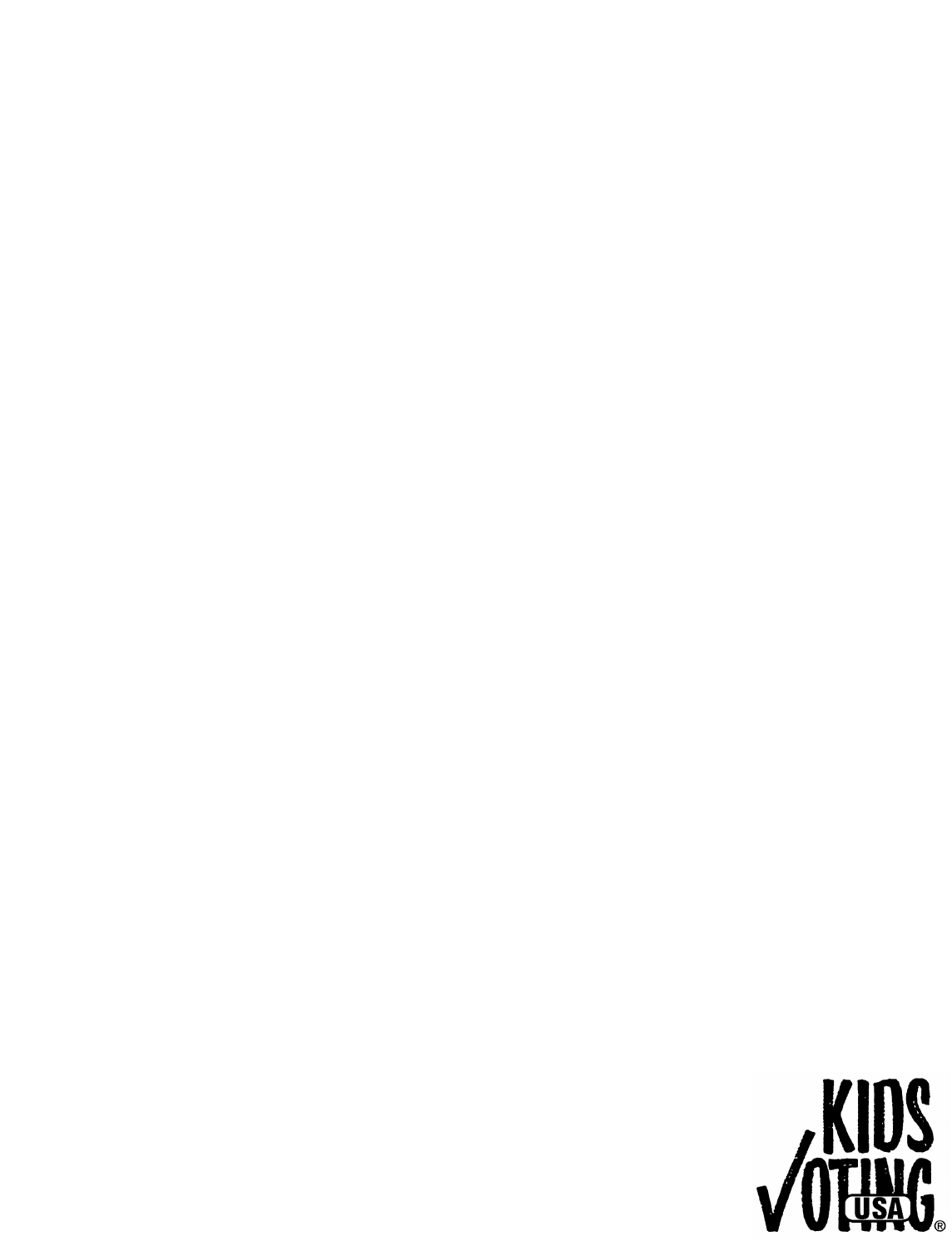
KIDS VOTING USA
K–2
CLASSROOM ACTIVITIES

Copyright © 2005 Kids Voting USA, Inc. All rights reserved.
The materials contained herein are protected by copyright laws, and may not be reproduced, republished, distributed,
transmitted or otherwise exploited in any manner without the express prior written permission of Kids Voting USA.
The Kids Voting USA name and logo and all related trademarks, trade names, and other intellectual property are the property
of Kids Voting USA and cannot be used without its express prior written permission.
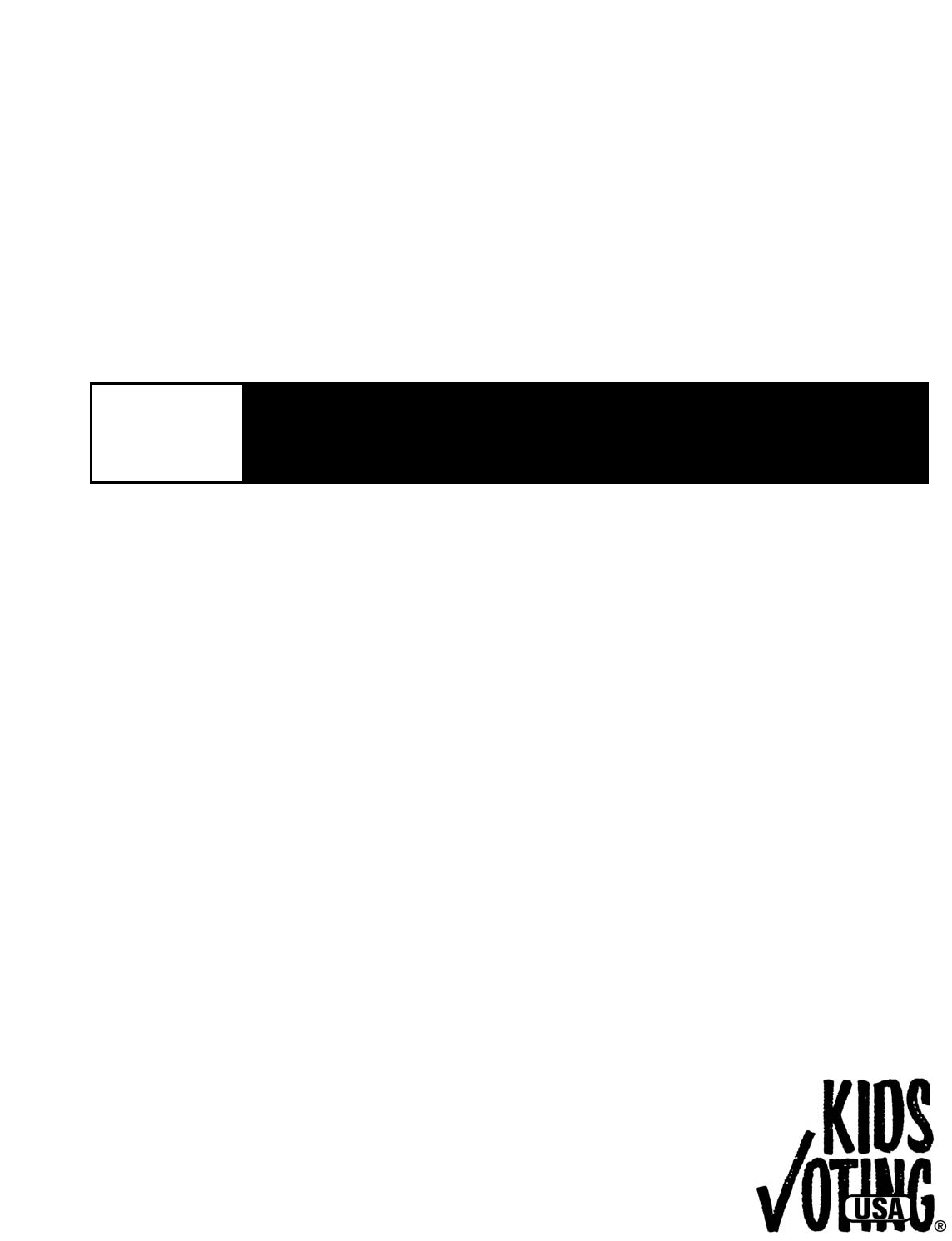
K–2
ELECTIONS AND VOTING
KIDS VOTING USA

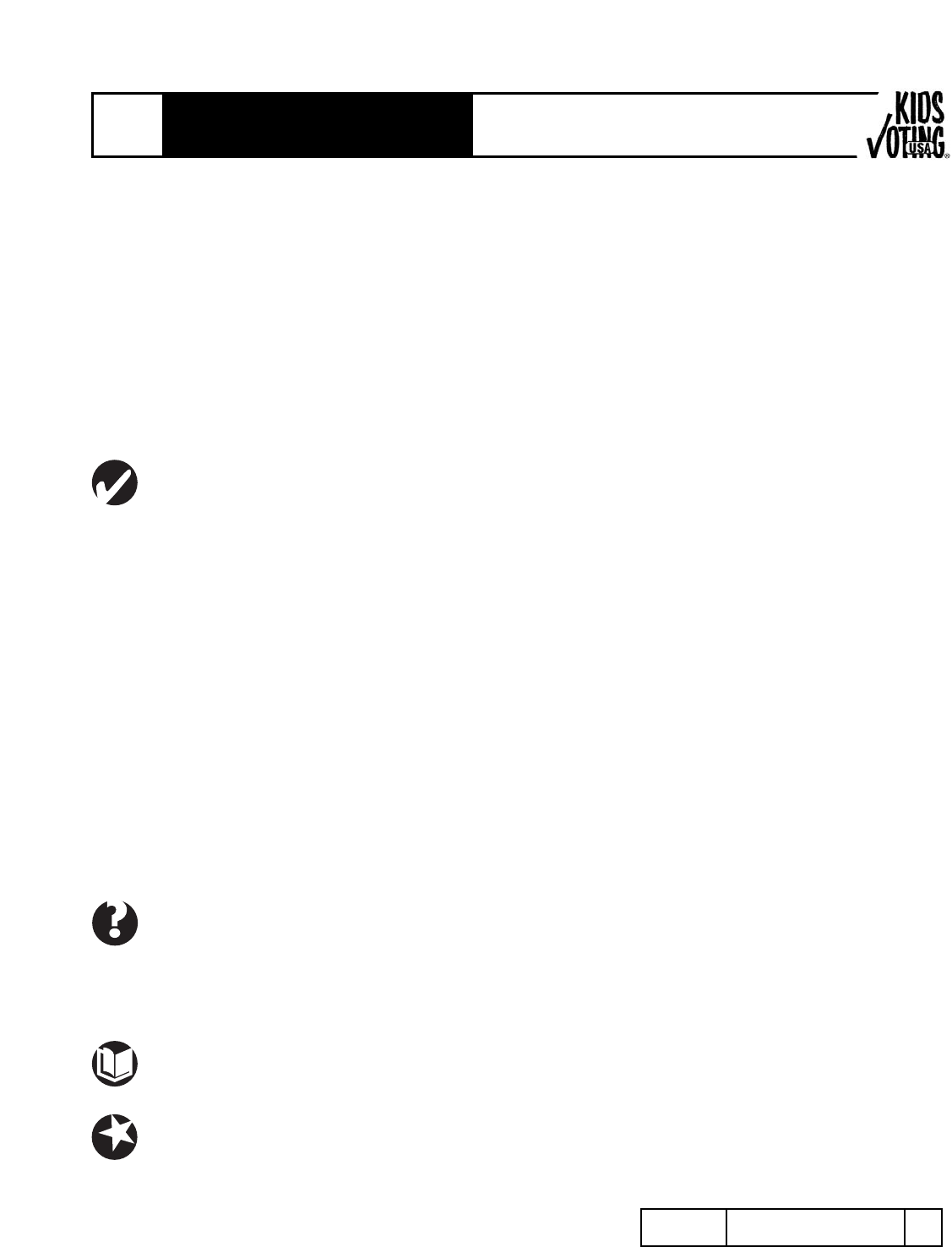
1ELECTIONS AND VOTINGGrades K-2
©2005 Kids Voting USA, Inc. – All rights reserved.
K–2
ELECTIONS AND VOTING
INTRODUCTION TO THEME
The intent of this theme is to educate students about elections, from gaining an appreciation of the power of
voting to studying the candidates and issues to understanding the registration process and participating in an
election. The theme’s activities fall under four main learning objectives:
• Students will develop an appreciation for the power and influence of voting.
• Students will learn how to study the candidates and issues relevant to an election.
• Students will understand what is involved in the registration and voting process.
• Students will learn how to stay involved with civic affairs after an election.
GENERAL ACTIVITIES
CONCEPT 1: MY VOTE GIVES ME POWER
The Odd Vote . . . . . . . . . . . . . . . . . . . . . . . . . . . . . . . . . . . . . . . . . . . . . . . . . . . . . . . . . . . . . . . . . . 2
Voting Chain . . . . . . . . . . . . . . . . . . . . . . . . . . . . . . . . . . . . . . . . . . . . . . . . . . . . . . . . . . . . . . . . . . 3
Yes Or No Game . . . . . . . . . . . . . . . . . . . . . . . . . . . . . . . . . . . . . . . . . . . . . . . . . . . . . . . . . . . . . . . . 5
CONCEPT 2: I STUDY THE CANDIDATES AND ISSUES
Which Hand? . . . . . . . . . . . . . . . . . . . . . . . . . . . . . . . . . . . . . . . . . . . . . . . . . . . . . . . . . . . . . . . . . . 7
Three Changes . . . . . . . . . . . . . . . . . . . . . . . . . . . . . . . . . . . . . . . . . . . . . . . . . . . . . . . . . . . . . . . . . 8
Election Bulletin Board . . . . . . . . . . . . . . . . . . . . . . . . . . . . . . . . . . . . . . . . . . . . . . . . . . . . . . . . . . 9
CONCEPT 3: I REGISTER AND VOTE
Kids Voting Registration . . . . . . . . . . . . . . . . . . . . . . . . . . . . . . . . . . . . . . . . . . . . . . . . . . . . . . . . 11
Voting Simulation . . . . . . . . . . . . . . . . . . . . . . . . . . . . . . . . . . . . . . . . . . . . . . . . . . . . . . . . . . . . . 14
Marking A Ballot . . . . . . . . . . . . . . . . . . . . . . . . . . . . . . . . . . . . . . . . . . . . . . . . . . . . . . . . . . . . . . 17
Pencil Flags . . . . . . . . . . . . . . . . . . . . . . . . . . . . . . . . . . . . . . . . . . . . . . . . . . . . . . . . . . . . . . . . . . 18
CONCEPT 4: I CONTINUE TO MAKE A DIFFERENCE
Marking The Winners . . . . . . . . . . . . . . . . . . . . . . . . . . . . . . . . . . . . . . . . . . . . . . . . . . . . . . . . . . 20
The Wish Tree . . . . . . . . . . . . . . . . . . . . . . . . . . . . . . . . . . . . . . . . . . . . . . . . . . . . . . . . . . . . . . . . 21
OVERARCHING QUESTIONS
Questions for Concept 1: My Vote Gives Me Power . . . . . . . . . . . . . . . . . . . . . . . . . . . . . . . . . . . . . . . . 23
Questions for Concept 2: I Study the Candidates and Issues . . . . . . . . . . . . . . . . . . . . . . . . . . . . . . . . 23
Questions for Concept 3: I Register and Vote . . . . . . . . . . . . . . . . . . . . . . . . . . . . . . . . . . . . . . . . . . . . 23
Questions for Concept 4: I Continue to Make a Difference . . . . . . . . . . . . . . . . . . . . . . . . . . . . . . . . . . 23
LITERATURE CONNECTION ACTIVITY
Duck For President by Doreen Cronin . . . . . . . . . . . . . . . . . . . . . . . . . . . . . . . . . . . . . . . . . . . . . . . . . . 24
CULMINATING ACTIVITY
I Go To The Polls . . . . . . . . . . . . . . . . . . . . . . . . . . . . . . . . . . . . . . . . . . . . . . . . . . . . . . . . . . . . . . . . . . . 25

2ELECTIONS AND VOTINGGrades K-2
©2005 Kids Voting USA, Inc. – All rights reserved.
K–2
ELECTIONS AND VOTING
My Vote Gives Me Power
OBJECTIVE
Students learn how to vote and implement
the results.
MATERIALS
No materials are necessary for this activity.
GET READY
Be prepared to create a tally chart on either
the whiteboard/chalkboard or a flip chart.
INSTRUCTIONS
Ask your students, Is there only one way to
vote? How do people vote for the President of
the United States? How do you think people
voted before there were machines? How do we
sometimes vote in class?
Say, Let’s vote in an odd way today.
Demonstrate these three ways to vote:
Agree: wave both your hands in the air
No opinion: Fold your arms across
your chest
Disagree: put both thumbs down and
stamp your feet
Make statements to vote on based on the
interests of your students, such as: Candy should
be outlawed. School should be half a day.
Invite students to make statements to be voted
on, like: I like spinach. Red is my favorite color.
Conclude by voting on a statement that can be
tallied and implemented immediately, such as:
We are going to vote on whether to have math
early in the day or later.
DISCUSSION QUESTIONS
# Do you like voting this way? Why or why not?
# Did your friends vote the same way you did?
Does this matter?
# Are there times when a vote should be private.
Why?
# On the final vote, did your vote give you any
power? How?
MORE!
Vote, tally, and implement as many decisions
as possible during the week. Help your
students understand the power of their votes
through action and discussion.
VOTE QUOTE
“By mutual confidence and mutual aid great
deeds are done, and great discoveries made.”
– Homer, The Illiad
THE ODD VOTE
(15 minutes)

3ELECTIONS AND VOTINGGrades K-2
©2005 Kids Voting USA, Inc. – All rights reserved.
K–2
ELECTIONS AND VOTING
My Vote Gives Me Power
OBJECTIVE
Students vote, tally, and implement the vote.
MATERIALS
Construction paper; Yes/No Sign handout; tape
GET READY
Cut a small strip of construction paper to
make a link for each child. Each strip of
construction paper will be a link in a chain.
Cut apart the Yes/No Sign handout.
Pin the Yes sign and the No sign to a bulletin
board so you can attach the students’ links as
they vote.
INSTRUCTIONS
Say to the children, Have you and your friends
ever had to make a decision about something
that was hard to agree on? Maybe you were
deciding what to watch on TV or where to eat.
How did you finally make the decision? Voting
is a fair way to make decisions.
Help the class choose an issue to vote on (such
as snacks, activities, or recess time) that can be
implemented immediately. State the issue as a
question to be answered “Yes” or “No.”
Give your students the strips of paper.
(You may ask them to write their names on
them or you can explain the concept of a
secret ballot where voting is confidential.)
Explain that one link on a voting chain
represents one vote.
Let each student link his/her “vote” under the
Yes sign or No sign.
DISCUSSION QUESTIONS
# Is the longest chain under the Yes sign or
under the No sign? Let’s count.
# Can you see your own voting link?
# Would the chain look different if you had
not voted?
# What might happen if you could vote as many
times as you wished rather than once?
# What do the results of our vote mean to us?
# Was this a fair decision?
MORE!
The class could vote on other issues during the
week in this way or in others.
VOTING CHAIN
(20-30 minutes)
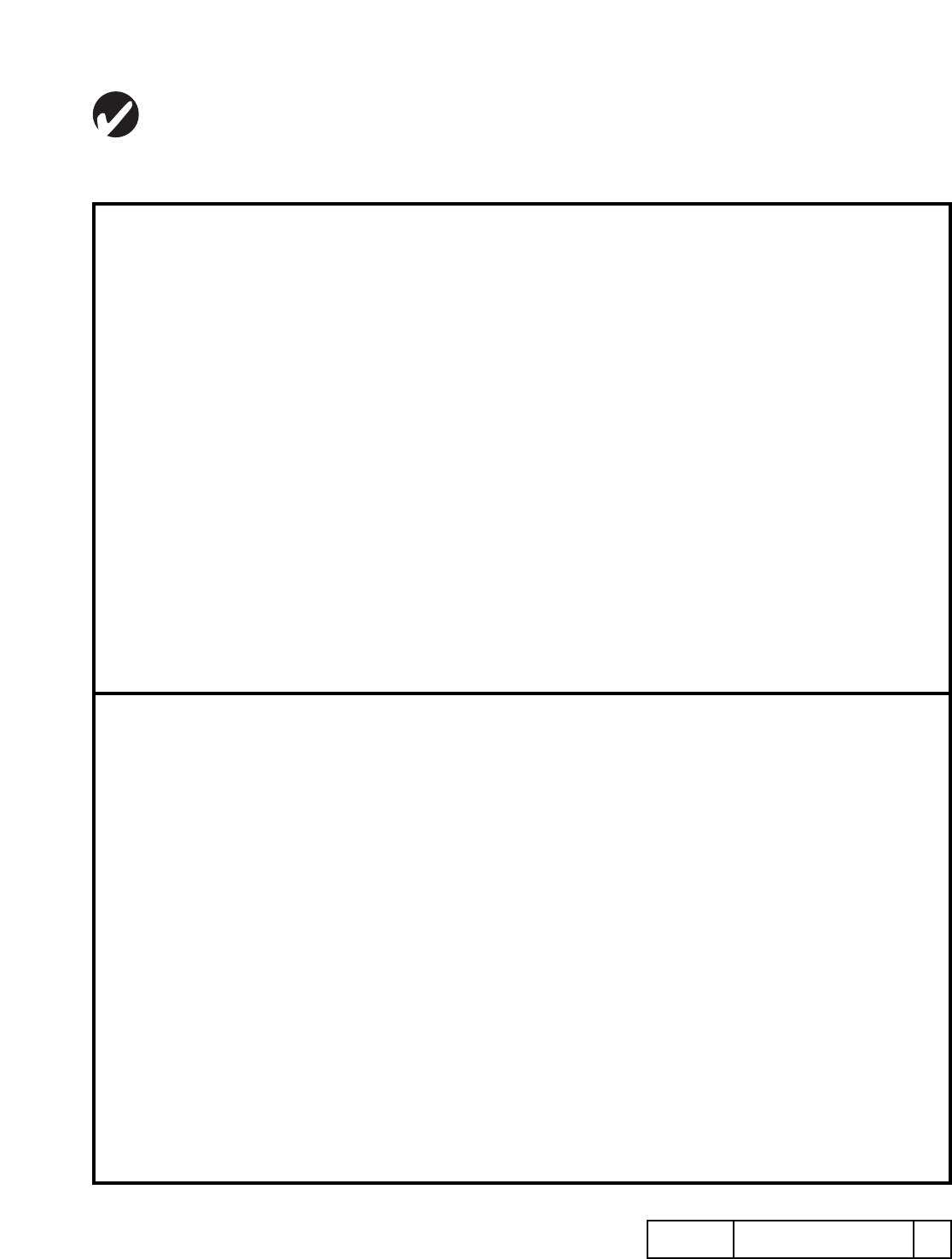
4ELECTIONS AND VOTINGGrades K-2
©2005 Kids Voting USA, Inc. – All rights reserved.
YES/NO SIGN
VOTING CHAIN
YES
NO

5ELECTIONS AND VOTINGGrades K-2
©2005 Kids Voting USA, Inc. – All rights reserved.
K–2
ELECTIONS AND VOTING
My Vote Gives Me Power
OBJECTIVE
Students vote and tally the results.
MATERIALS
Yes & No Cards handout; popsicle sticks
GET READY
Copy and cut out the Yes card and the No card
from the Yes & No Cards handout.
Attach the two cards to popsicle sticks, if desired.
INSTRUCTIONS
As a class, brainstorm 10 to 15 statements that
can be judged with a vote of yes or no. Have
fun with this list. Some suggestions are:
I like broccoli. I like the color blue. I wish I
could fly. School should be all year round.
It was okay for Goldilocks to go inside the
bears’ house. All whale killing should be
stopped. There is too much violence on TV.
Either designate a student leader or lead the
activity yourself.
Announce the first issue to be voted on.
Hold up the Yes sign and point to one side of
the room. Have students wishing to vote Yes
go to that side of the room.
Hold up the No sign and point to the other
side of the room. Have students wishing to
vote No go to that side of the room.
Continue to do the same thing for the rest of
the statements.
Hold a final vote that can be implemented
directly such as, “We will do math next.”
Tally each vote, write the results on the
blackboard, and implement the vote.
DISCUSSION QUESTIONS
# Did the same people vote “Yes” on every issue?
Did the same people vote “No?”
# Did any of your friends vote “Yes” when you
voted “No,” or “No” when you voted “Yes”?
How did that make you feel?
# Did you think about changing your vote to be
on the same side as a friend?
# Would you have voted differently if this had
been a secret ballot?
# Might a secret vote be important sometimes?
When?
# Which vote gave you power? What power did
it give you?
# How does voting give adults power?
MORE!
During the next week, vote as often as possible
on issues that can be implemented in the
classroom so students can see the direct
relationship between their votes and their lives.
YES OR NO GAME
(15-20 minutes)
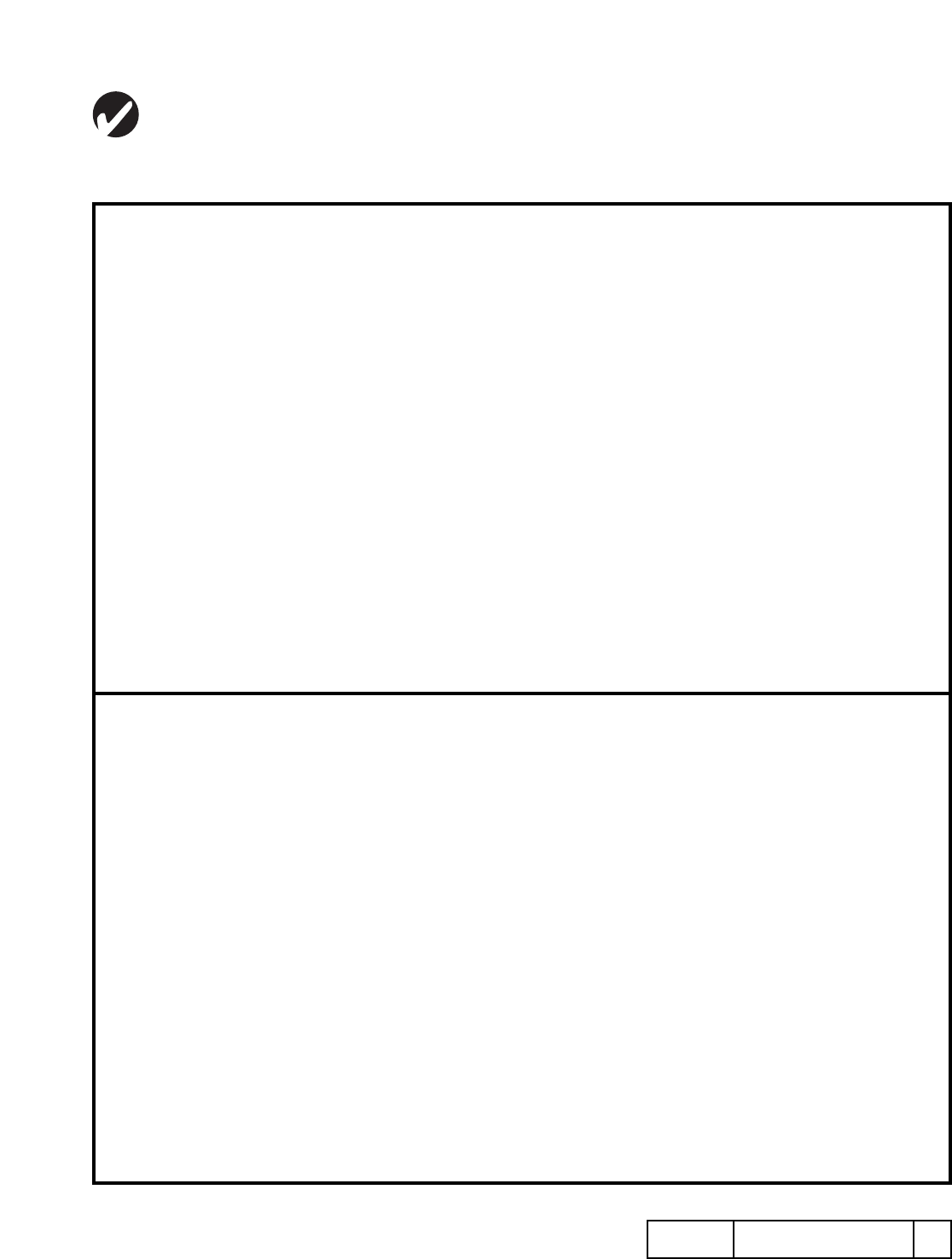
6ELECTIONS AND VOTINGGrades K-2
©2005 Kids Voting USA, Inc. – All rights reserved.
YES & NO CARDS
YES OR NO GAME
YES
NO

7ELECTIONS AND VOTINGGrades K-2
©2005 Kids Voting USA, Inc. – All rights reserved.
K–2
ELECTIONS AND VOTING
I Study the Candidates and Issues
OBJECTIVE
Students gather information before making
a decision.
MATERIALS
Small prizes, such as stickers or pieces of
candy (preferably something you can hide in
one hand)
GET READY
Make sure you have the small prizes ready and
that there is enough for your entire class.
INSTRUCTIONS
Say to your students, Each of you can guess
which one of my hands is holding a prize. You
will have a better chance at guessing correctly
if you ask for information first. Information
will help you make a better decision.
Call your students one at a time to guess
which hand holds the prize.
Ask each member of your class if they would
like some information. If they do, give a clue
such as: Choose the hand closest to the window
or The hand moving up and down is empty.
Allow children who choose the wrong hand to
try again later.
DISCUSSION QUESTIONS
# Did information help you make a good choice?
# Can information help you make a good choice
when choosing a leader?
# Where can you find information about people
who want to be our leaders?
MORE!
Encourage students to bring in information
they find on the election such as newspaper
articles, pictures, cartoons, bumper stickers,
etc., and display them on a Kids Voting
bulletin board.
VOTE QUOTE
“If a nation expects to be ignorant and free in a
state of civilization, it expects what was never
meant to be.” – Thomas Jefferson
WHICH HAND?
(15 minutes)

8ELECTIONS AND VOTINGGrades K-2
©2005 Kids Voting USA, Inc. – All rights reserved.
K–2
ELECTIONS AND VOTING
I Study the Candidates and Issues
OBJECTIVE
Students study each other carefully to improve
information-gathering skills.
MATERIALS
No materials are necessary for this activity.
GET READY
Divide your students into teams of two.
Have students in the pairs face each other.
INSTRUCTIONS
Say to your students, Perhaps you have lost
some money or a toy in a room that you often
play in. When you did, you probably looked
around the room much more carefully than
ever before. When we need to, we can observe
or study a person or thing very carefully.
In this game you will practice observing
carefully. (All teams will play simultaneously.)
Tell the students to look at each other carefully.
When you say, Three changes, direct them to
turn back-to-back and make three changes in
their appearance: change their hair, untie their
shoelaces, tuck in their shirt, etc.
When they have made the changes, say, Face
each other.
Ask the students to identify the changes their
partners have made.
Students can play several times, changing
partners occasionally.
DISCUSSION QUESTIONS
# Did you get better at observing another person?
# Do you think we should carefully observe a
person who wants to be our leader? Why?
# How can we get information about a person
who wants to be our leader?
# What information do we need to know about a
person who wants to be our leader?
# Who is currently looking to be our leader?
# What information do you have about them?
How can you find out more?
MORE!
Encourage your students to bring to class
any election paraphernalia they find. Ask
them to look in magazines, newspapers, and
mailed brochures. Pin this information to a
bulletin board.
THREE CHANGES
(15-20 minutes)

9ELECTIONS AND VOTINGGrades K-2
©2005 Kids Voting USA, Inc. – All rights reserved.
K–2
ELECTIONS AND VOTING
I Study the Candidates and Issues
OBJECTIVE
Students share election-oriented information
they gather from the media by constructing a
bulletin board of articles and pictures.
MATERIALS
Colored pencils and crayons; Election Bulletin
Board handout
GET READY
Gather colored pencils and crayons.
Prepare a bulletin board in the classroom that
can be used for election information.
Prepare a note on the back of the Election
Bulletin Board handout to go home with the
children that explains the assignment: With
parents or guardians, each student will look for
one article or picture about the election, and
attach it to the paper. (Students may alter-
natively draw a picture about the election.)
Sample note to families: Our class is making
a special Kids Voting bulletin board and each
student will help by attaching an article about
the election to this paper. Please help your
child to find an article or picture by the end
of the week. If you cannot find one together,
the student can draw a picture about the
election instead.
Duplicate one handout for each student, with
the picture of people talking on one side and
the note to families on the other.
INSTRUCTIONS
After you pass out the handout, ask the students
to write their names above the caption bubble.
Look at the picture together. Say, People are
talking to each other in this picture. Who are
the people talking? (“a lady who is cleaning
her house,” “an old man,” etc.) Give your
students some time to color in the people.
Say, Have you been hearing people talk about
the election at home or on television? One of
the most important things people can say
about the election is to remind each other:
“Vote!” Let’s write that word in our bubble so
it looks like everyone is saying it.
Write V-O-T-E on the board for your students
to copy.
Explain that the students can post their papers
on the Kids Voting bulletin board when there is
a picture/article about the election attached to it.
Tell the students that the letter on the back of
the handout is asking their families to help
them find or draw a picture.
DISCUSSION QUESTIONS
# Where will you look for a picture about the
election? Who will help you to find one?
# If you can’t find a picture, what kind of picture
could you draw? (A ballot, a voter = person
holding a ballot, a candidate = person
running or office, etc.)
ELECTION BULLETIN BOARD
(5 minutes a day for two weeks)
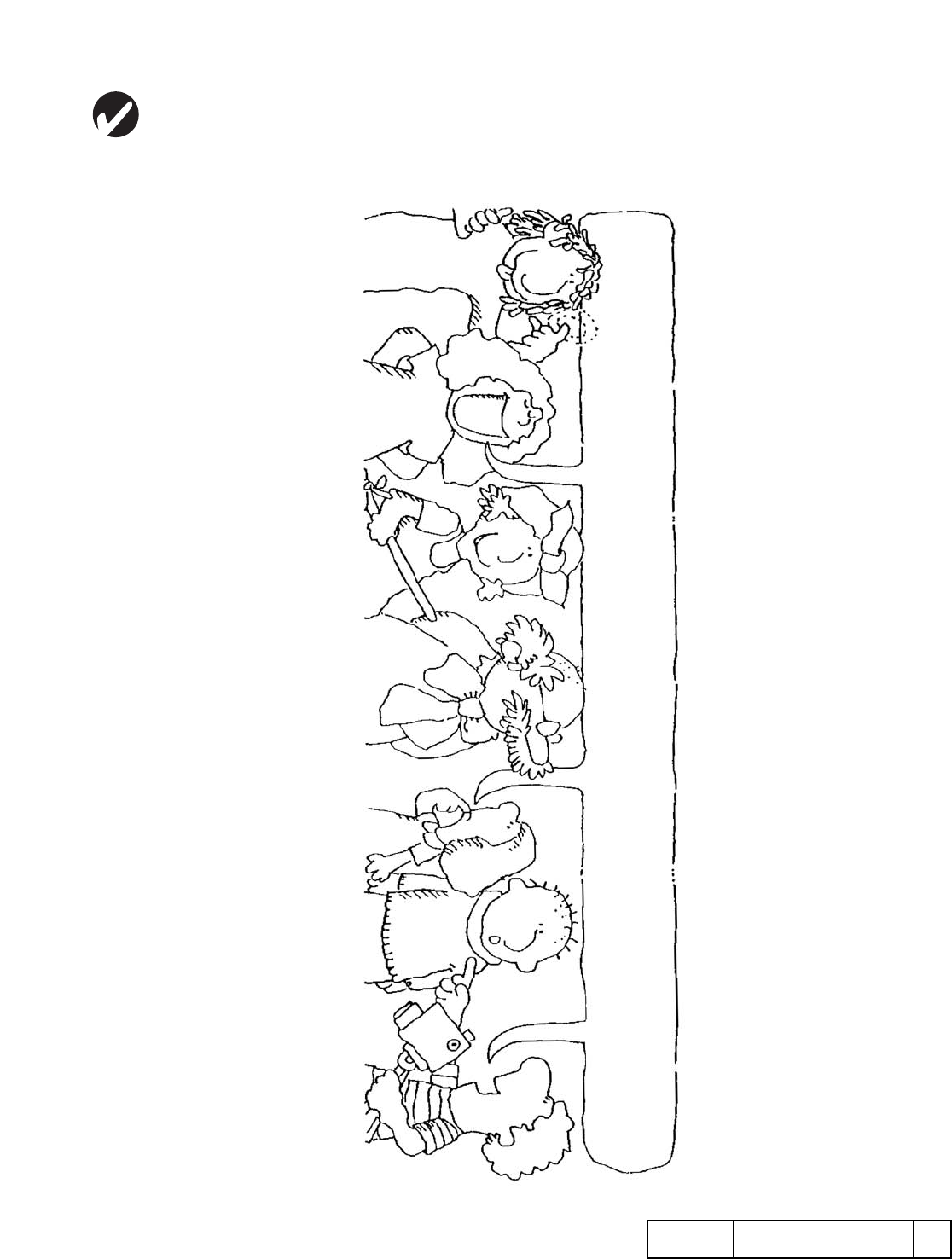
10ELECTIONS AND VOTINGGrades K-2
©2005 Kids Voting USA, Inc. – All rights reserved.
ELECTION BULLETIN BOARD
ELECTION BULLETIN BOARD

11ELECTIONS AND VOTINGGrades K-2
©2005 Kids Voting USA, Inc. – All rights reserved.
K–2
ELECTIONS AND VOTING
I Register and Vote
OBJECTIVE
Students understand the importance of
registering to vote.
MATERIALS
Voter Registration Cards handout; Registration
Badges handout; lined paper
GET READY
Copy enough Voter Registration Cards for your
students.
Prepare three Registration Badges – cut them
out from the handout. If possible, print them
out on colored paper.
Put two or three tables or desks together at the
front of the room.
For more information, see “Elections” in
the Appendix.
INSTRUCTIONS
Say to your students, Have you ever signed up
for swimming lessons or school? If so, you
probably had to go in before the first day of
class and sign up. Another word for signing up
is “registering.” Before you can vote you must
register to put your name on the list of voters.
Assign three students to be the registrars for the
class. Give each registrar a Registration Badge.
Give each registrar a stack of Registration
Cards and a registration sheet. (The registra-
tion sheet could be a piece of lined paper
folded down the middle.) Have the registrars
sit at the desks/chairs you put together.
Instruct the students to come to the
tables/desks three at a time to fill out their
Registration Cards and sign the registration
sheets. (Have the students sign their names on
the left side of the registration sheet.)
Each student goes to one registrar who helps
them through the registration process, so it is
important that the registrars know how the
process works.
Have the registrars switch roles with students
who have already registered so that they have a
chance to register.
Tell your students that you will send the
Registration Cards home with them the day
before the Kids Voting election so they can
take them to the polls.
Save the registration sheet for the Voting
Simulation activity.
DISCUSSION QUESTIONS
# Why do we register?
# What could happen if people voted without
registering?
MORE!
As an alternative to classroom registration,
help coordinate a school registration day for
both students and parents. Invite a deputy
registrar for parents and let students register
for the Kids Voting election at the same time.
KIDS VOTING REGISTRATION
(20-30 minutes)
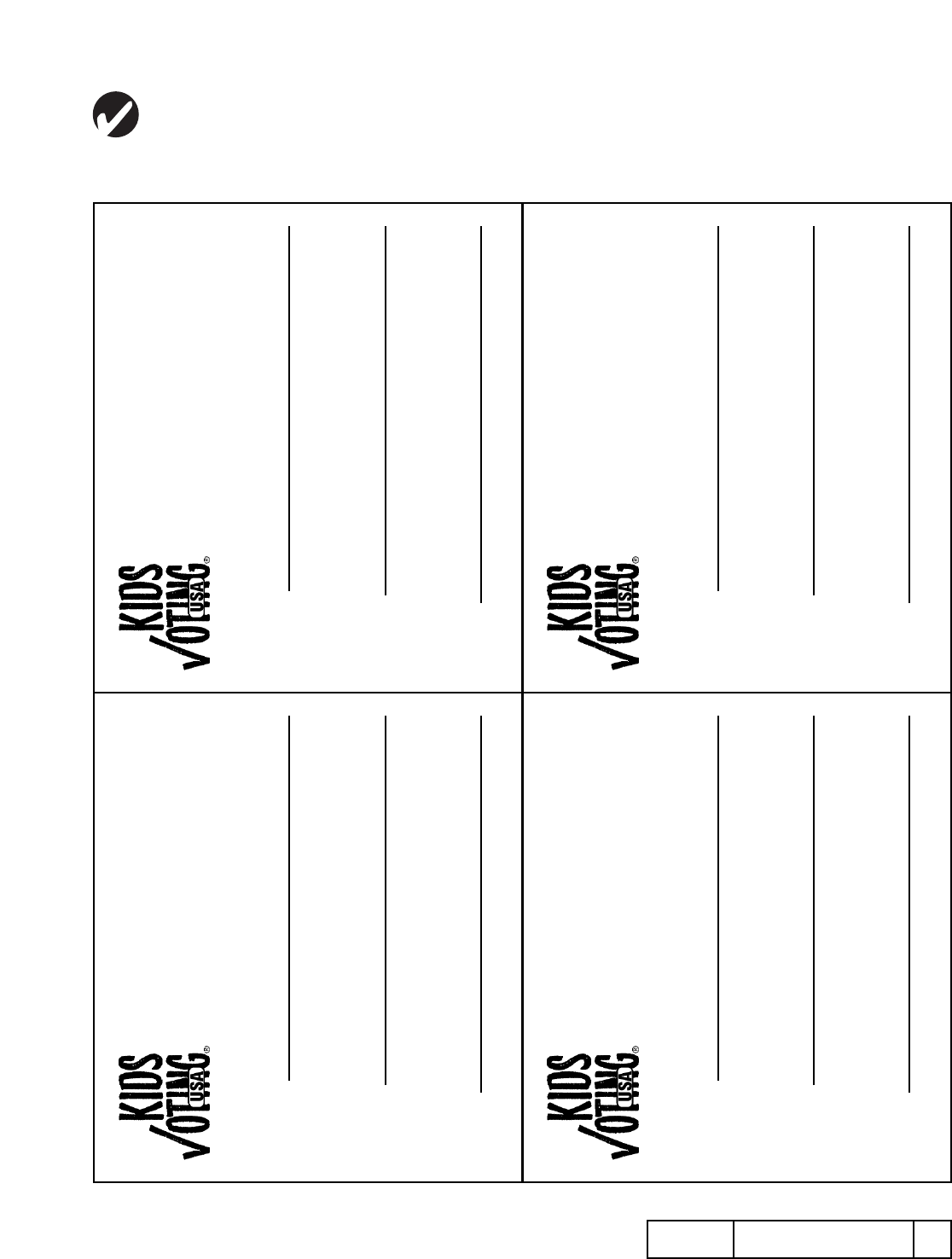
12ELECTIONS AND VOTINGGrades K-2
©2005 Kids Voting USA, Inc. – All rights reserved.
VOTER REGISTRATION CARDS
KIDS VOTING REGISTRATION
Voter Registration
Student
Teacher
School
Voter Registration
Student
Teacher
School
Voter Registration
Student
Teacher
School
Voter Registration
Student
Teacher
School
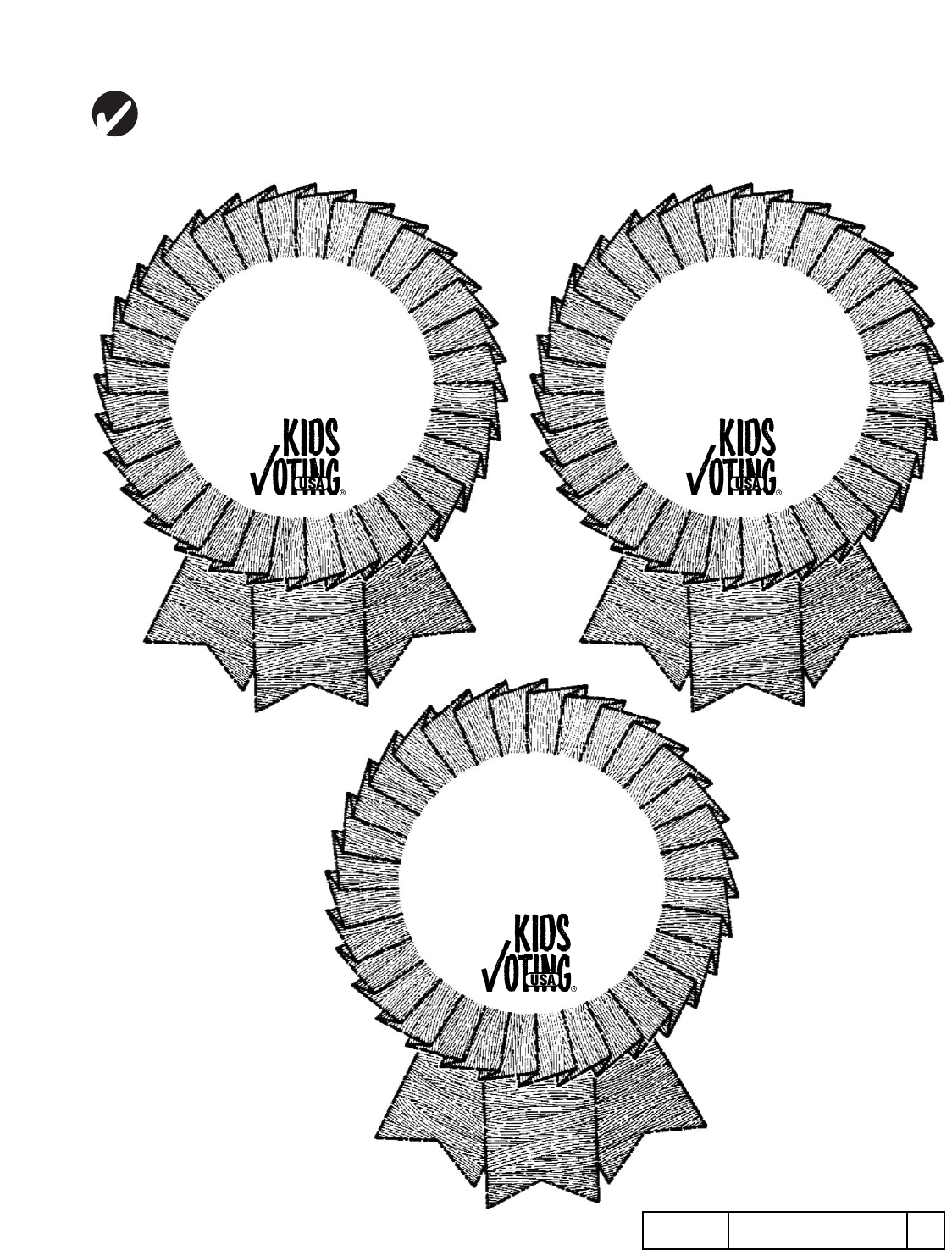
13ELECTIONS AND VOTINGGrades K-2
©2005 Kids Voting USA, Inc. – All rights reserved.
REGISTRATION BADGES
KIDS VOTING REGISTRATION

14ELECTIONS AND VOTINGGrades K-2
©2005 Kids Voting USA, Inc. – All rights reserved.
K–2
ELECTIONS AND VOTING
I Register and Vote
OBJECTIVE
Students vote in a simulated polling place to
become familiar with the voting process.
MATERIALS
Polling Place Diagram handout; Ballots handout;
material for a ballot box and voting booth
GET READY
Choose an issue that will impact the students
rather quickly. For instance, vote on what to
play at recess or how to determine seating or
something fun like, What tastes best:
a chocolate chip or peanut butter cookie?
Prepare ballots from the Ballots handout or
determine a way to vote on blank pieces of paper.
Prepare a simple ballot box and voting booth.
Arrange a corner of the classroom to resemble
a polling place as shown in the diagram.
INSTRUCTIONS
Explain the duties of the precinct workers
(see handout) and assign students to role play
the part of the workers. Seat them as shown
in the diagram.
Give one of the judges the registration sheet
derived from the Kids Voting Registration
activity.
Give the clerks lined paper to record the voters
as they come in.
Hand the ballots to the other judge.
Seat the marshal by the ballot box.
Ask a student to demonstrate by casting the
first vote.
Let each student go through the voting process.
Instruct the marshal to tally and announce
the vote.
Implement the vote.
DISCUSSION QUESTIONS
# Who can go into a polling place?
# Have you ever gone with your parents? If yes,
what was it like?
# How do adults know where to go to vote?
# If they don’t know, how can they find out?
# Can everybody vote?
# Have you voted at the Kids Voting booth
before? What was it like?
# Where will you go to cast your Kids Voting
vote this election?
# Are there any rules in a polling place?
# What do you think are good manners for a
polling place?
VOTING SIMULATION
(30 minutes)
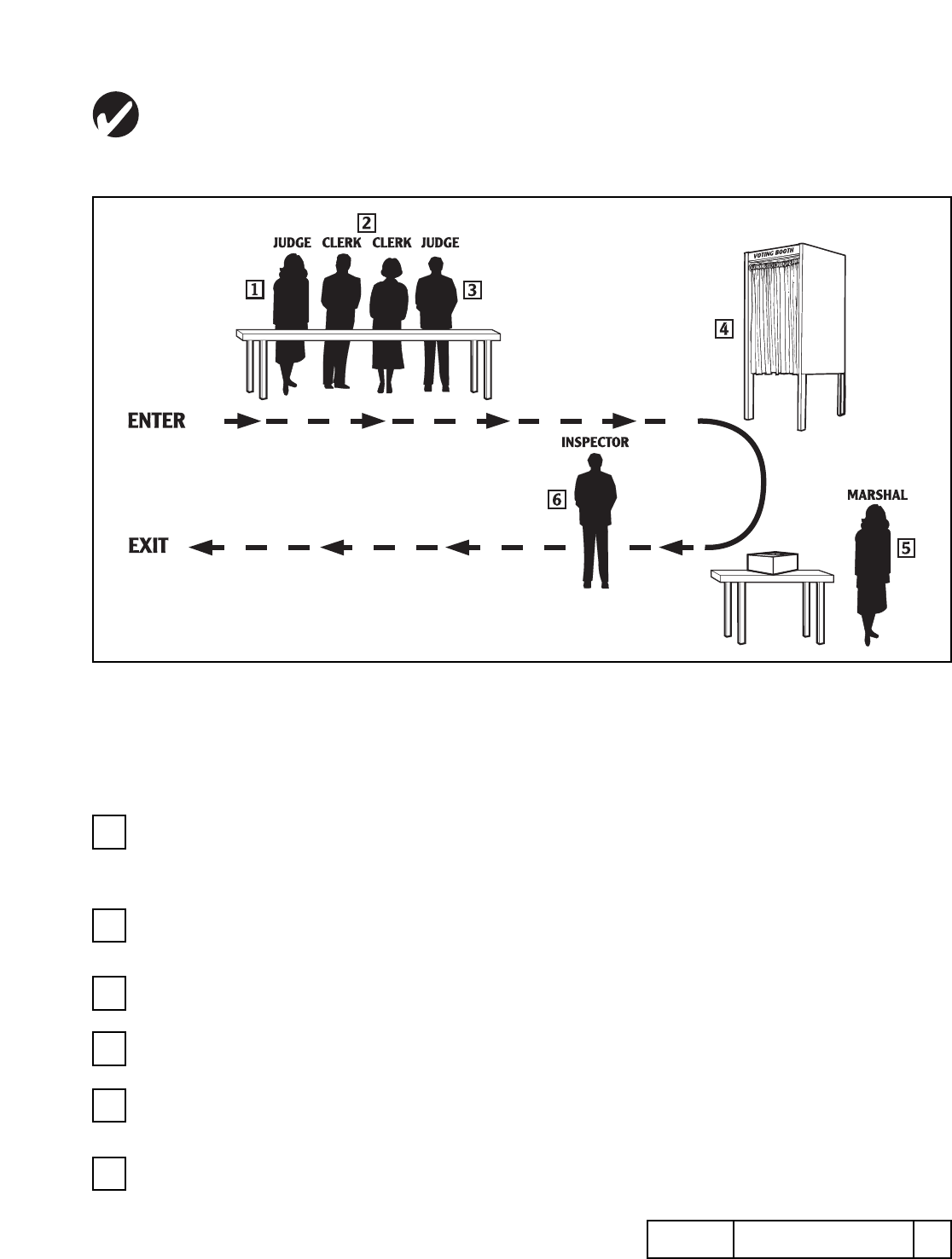
15ELECTIONS AND VOTINGGrades K-2
©2005 Kids Voting USA, Inc. – All rights reserved.
POLLING PLACE DIAGRAM
VOTING SIMULATION
At the polls there are usually: one inspector; two judges — one
Republican, one Democrat; two clerks — one Republican, one
Democrat; and one marshal.
As you enter you will generally meet:
A judge with the register, a list containing the names of
registered voters in the precinct, who will ask your name,
find it in the register, and ask you to sign beside it
Two clerks, one for each party, who will add your name to a
list to witness that you have voted
Another judge, who will hand you your ballot, and help you
understand how to cast your ballot
A voting booth
The marshal, who will take your ballot and place it in the
ballot box
The inspector, who oversees the polling place and assigns all
the workers their duties
Poll workers have other duties. For
instance the marshal makes sure that
the law is kept. She watches that no one
campaigns within 150 feet of the polls
and she checks to see that everyone in
line when the poll closes gets a chance
to vote.
You, the voter, will:
1. Sign in by writing your name in
the register
2. Take a ballot from a judge
3. Go to the booth and vote
4. Return your ballot to the marshal
1
2
3
5
6
4
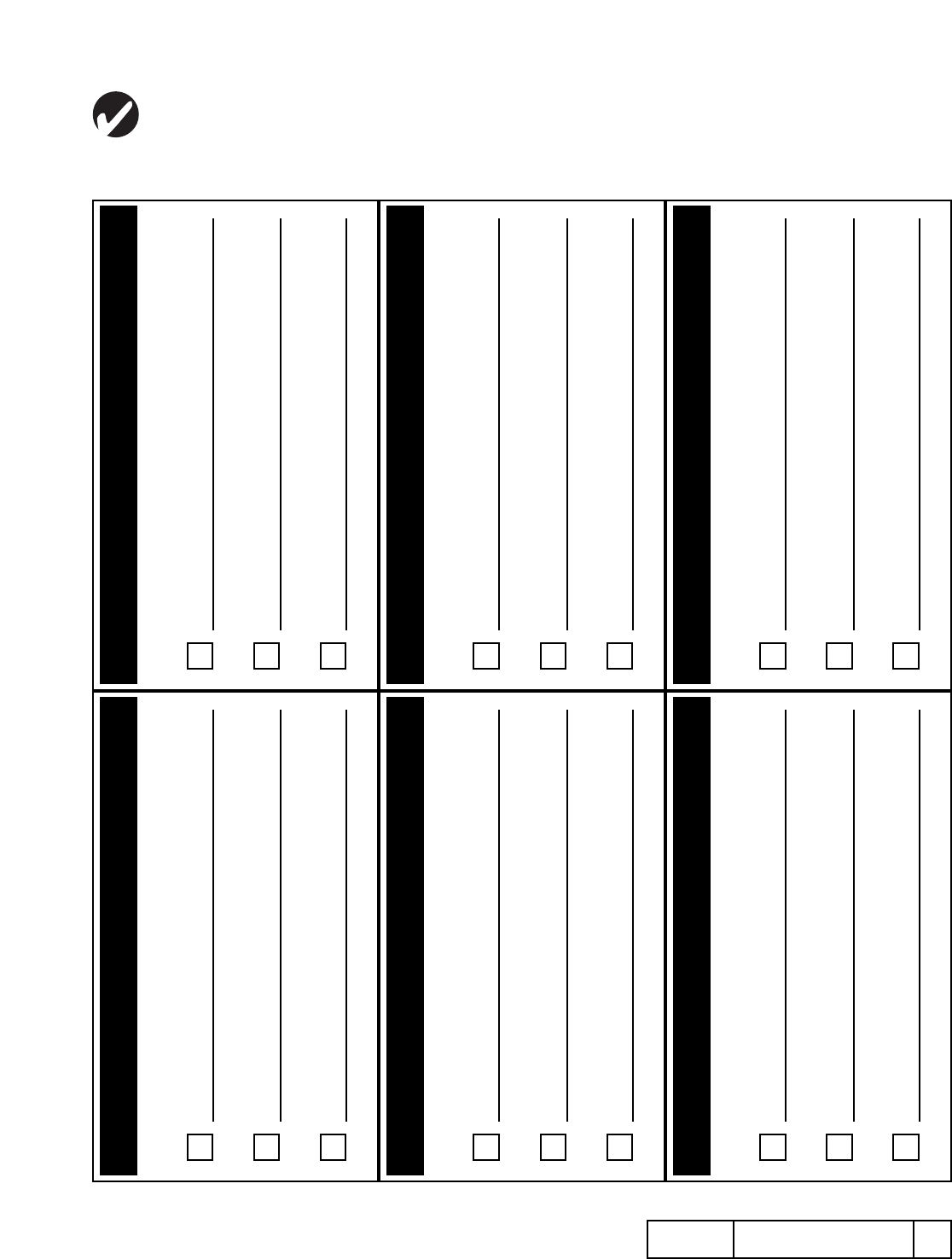
16ELECTIONS AND VOTINGGrades K-2
©2005 Kids Voting USA, Inc. – All rights reserved.
BALLOTS
VOTING SIMULATION
BALLOT
VOTE FOR ONE
BALLOT
VOTE FOR ONE
BALLOT
VOTE FOR ONE
BALLOT
VOTE FOR ONE
BALLOT
VOTE FOR ONE
BALLOT
VOTE FOR ONE

17ELECTIONS AND VOTINGGrades K-2
©2005 Kids Voting USA, Inc. – All rights reserved.
K–2
ELECTIONS AND VOTING
I Register and Vote
OBJECTIVE
Students study and mark sample ballots.
MATERIALS
Sample Kids Voting Ballot
GET READY
Copy a sample Kids Voting Ballot for each
student. (If you have not received them, check
with your Kids Voting contact person.)
INSTRUCTIONS
Study the ballot with your students.
Identify the pictures and issues you feel
they can understand.
Ask your students to pretend they are at the
polls and have them mark their ballots.
DISCUSSION QUESTIONS
# How did you decide who to vote for?
# How do grown-ups decide who to vote for?
# Where do they get their information?
# What can you do if you don’t know who to
vote for? (Ask for help from a parent or
guardian; listen to the commercials on TV
or the radio; etc.)
# Where will you go to mark a Kids Voting ballot?
MORE!
Encourage your students to take their ballots
home and discuss the candidates and issues
with their families.
VOTE QUOTE
“If a nation expects to be ignorant and free in a
state of civilization, it expects what was never
meant to be.” – Thomas Jefferson
MARKING A BALLOT
(15-20 minutes)

18ELECTIONS AND VOTINGGrades K-2
©2005 Kids Voting USA, Inc. – All rights reserved.
K–2
ELECTIONS AND VOTING
I Register and Vote
PENCIL FLAGS
(20-30 minutes)
OBJECTIVE
Students advocate voting.
MATERIALS
Pencil Flag Format handout; old newspapers
and magazines (optional); scissors, tape,
and glue
GET READY
Copy and cut a Pencil Flag Format for
each student.
Gather old newspapers and magazines (optional).
Gather scissors, tape, and glue.
Write the word VOTE on the board.
INSTRUCTIONS
Tell your students that they can help our
country by reminding others to vote. Explain
that this project will help them remind others.
Instruct your students to find and cut the
letters V, O, T, and E from magazines and
newspapers (or use the letters on the format).
Help them paste the letters on the flag format.
They can then add designs and color.
Help them tape/fasten the flags to their pencils.
Have your students use the flags at school for a
few days, then tell them to take them home to
remind adults to vote. They could stick the
pencil flags in a plant or flower arrangement
(with permission) or just use them as pencils.
DISCUSSION QUESTIONS
# When is election day?
# What word is on your flag?
# Why should we vote?
# Who can you remind to vote with your
pencil flag?
# Who can you remind to take you to vote?
MORE!
As a grade level or whole school project, have
classes make flags large enough to be read
from the street and hang them in front of the
school to remind the community to vote.
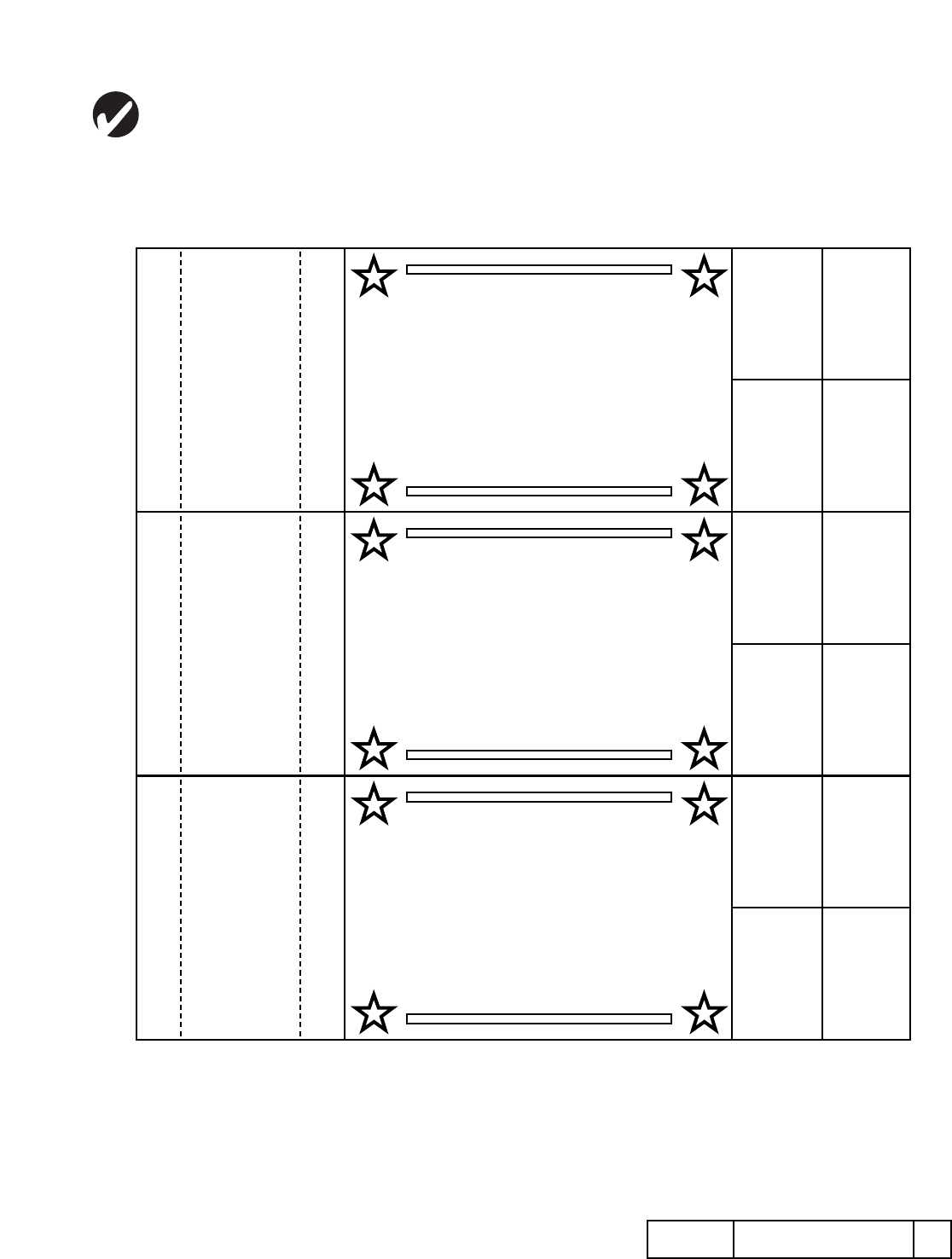
19ELECTIONS AND VOTINGGrades K-2
©2005 Kids Voting USA, Inc. – All rights reserved.
PENCIL FLAG FORMAT
PENCIL FLAGS
VO
TE
VO
TE
VO
TE

20ELECTIONS AND VOTINGGrades K-2
©2005 Kids Voting USA, Inc. – All rights reserved.
K–2
ELECTIONS AND VOTING
I Continue to Make a Difference
MARKING THE WINNERS
(5-10 minutes)
OBJECTIVE
Students monitor the returns to stay
politically active.
MATERIALS
Kids Voting Ballot
GET READY
Prepare monitoring ballots by writing the
following on a sample Kids Voting Ballot:
Place a check by the candidate or issue that is
ahead at your bedtime. Circle the candidate or
issue that has won or is ahead just before you
leave for school.
Make a copy of the monitoring ballot for
each student.
INSTRUCTIONS
Read the instructions you wrote on the ballot
to the students.
Instruct the students to take their monitoring
ballots home and watch the returns on TV.
Ask them to bring their ballots back the next day.
DISCUSSION QUESTIONS
For election day:
# Which candidates/issues do you think will win?
# How might you feel if a person you voted for
does not win?
# What can you do if a person you voted for does
not win?
For the day after elections:
# Who won? Who is the leader of our (country,
state, city, school board, etc.)?
# Why do you think they won?
# How can we support our leaders?
# Do you have any sad or happy feelings?
# Did the people at your house talk about the
elections? Would you like to share what
they said?
# Now that we have voted, how else can we help
our country?
MORE!
As a class, write a letter of congratulations to a
winning candidate or a letter of consolation to
a losing candidate. Let all the students sign
their names. Send it by e-mail if possible.

21ELECTIONS AND VOTINGGrades K-2
©2005 Kids Voting USA, Inc. – All rights reserved.
K–2
ELECTIONS AND VOTING
I Continue to Make a Difference
OBJECTIVE
Students make wishes for their country
regarding changes they would like to see.
MATERIALS
Star Cards handout; art supplies (crayons,
markers, etc.); yarn; a hole puncher; scissors
GET READY
Find a large, bare branch and place it in a pot
filled with pebbles, or design a large tree out of
paper on the bulletin board. (Alternatively find
a bare tree outside for this activity.)
Copy and cut apart a star card for each student.
Gather: one 8-inch-long piece of string or yarn
for each student; crayons, markers, or colored
pencils; scissors; and a hole puncher.
INSTRUCTIONS
Instruct your students to cut out the star card,
fold it in half, and color or decorate the cover.
As they are working, ask them to think of a wish
they would like to come true for our country.
For example: I wish we could lower crime rates.
Help them draw or write their wish on the
inside of the card and sign their names.
Help them punch a hole in the corner and tie
string through the hole.
Hold a ceremony so the students can tie their
cards to the tree. They may read or describe
their wishes as they place them on the tree or
students may discover the wishes on their own
at a later time.
DISCUSSION QUESTIONS
# Can wishes come true?
# How can our wishes for our country come true?
# Is there anything a young person can do to
help these wishes come true?
# Does this Kids Voting activity count as
helping? If so, why?
# If we practice self-discipline and patience in
our classroom, might that help?
# Can you think of anyone who had a wish or a
dream for our country and made it come true?
Tell us about it.
MORE!
Brainstorm and vote on a wish for our country
that your class can make come true, such as a
cleaner school or park. Work together to make
it happen!
THE WISH TREE
(30-45 minutes)
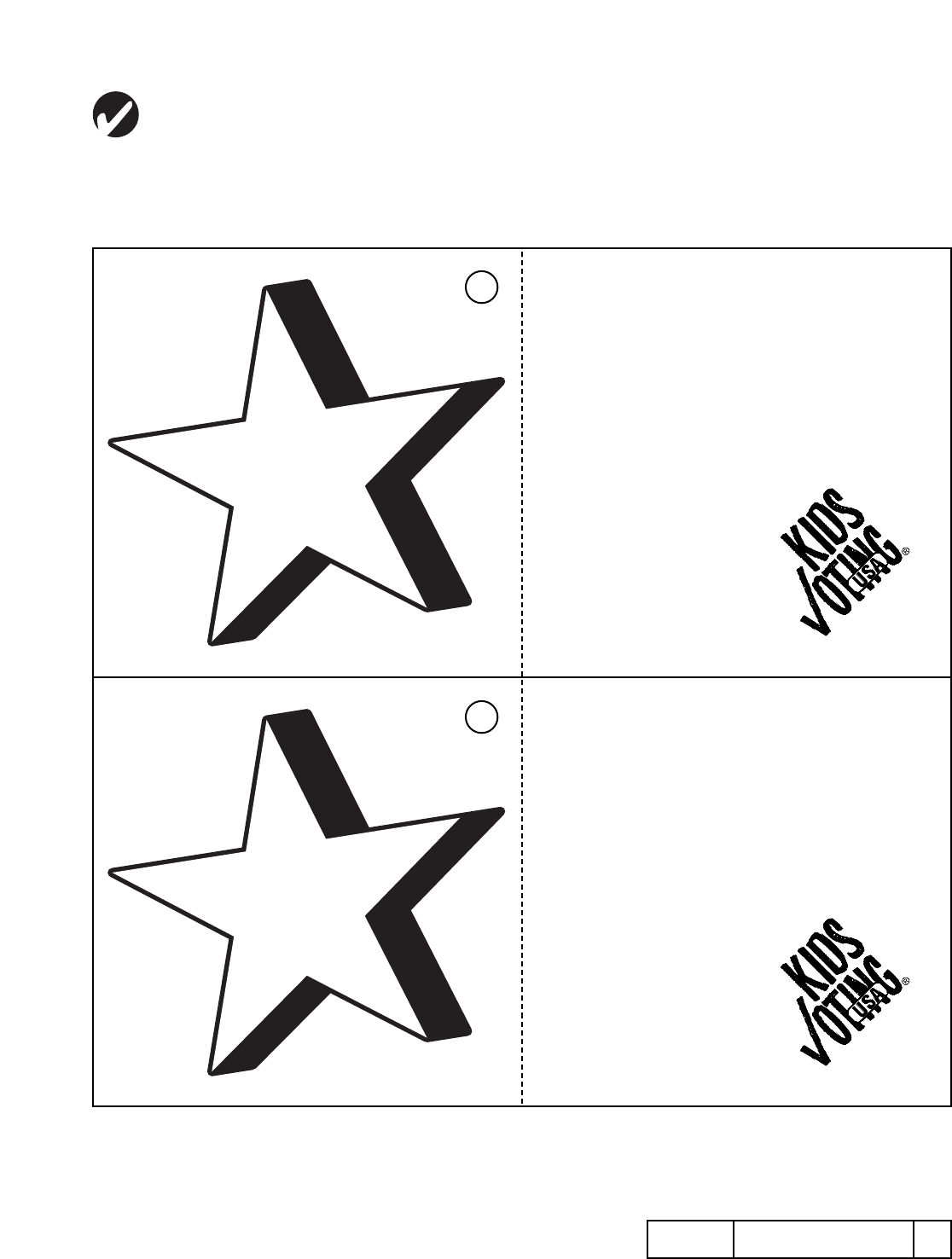
22ELECTIONS AND VOTINGGrades K-2
©2005 Kids Voting USA, Inc. – All rights reserved.
STAR CARDS
THE WISH TREE
“How lovely to think that no one need wait a moment.
We can start slowly changing the world. How lovely
that everyone great and small can make a contribution.”
– Anne Frank
“How lovely to think that no one need wait a moment.
We can start slowly changing the world. How lovely
that everyone great and small can make a contribution.”
– Anne Frank

23ELECTIONS AND VOTINGGrades K-2
©2005 Kids Voting USA, Inc. – All rights reserved.
K–2
ELECTIONS AND VOTING
MY VOTE GIVES ME POWER
# What is a vote?
# What does voting do?
# Does voting make a difference? How?
# What is an election?
# What is the purpose of an election?
# What power does voting have?
I STUDY THE CANDIDATES AND ISSUES
# What does it mean to study something?
# What is a candidate?
# What does a candidate hope to do?
# Do you know any candidates in this election?
# What is an issue?
# Can you give an example of an issue?
# What issues are important to you?
# Why is it important to study the candidates?
# Why is it important to study the issues?
I REGISTER AND VOTE
# What does it mean to register?
# What do you think you do when you register?
# Why is it important to register?
# Do you need to register before you vote?
# Why is it important to vote?
# What do you accomplish when you register and vote?
I CONTINUE TO MAKE A DIFFERENCE
# What does it mean to make a difference?
# Does voting make a difference?
# What else can you do to make a difference?
# Do candidates make promises? Can you give me an example?
# Do all candidates keep the promises they make once they are elected?
# What can you do to make sure that candidates keep their promises when they are elected?
# What do you think is important to do once an election is over?
OVERARCHING QUESTIONS

24ELECTIONS AND VOTINGGrades K-2
©2005 Kids Voting USA, Inc. – All rights reserved.
K–2
ELECTIONS AND VOTING
OBJECTIVE
Students investigate elections and the
voting experience.
MATERIALS
Duck For President - Doreen Cronin
PRE-READING ACTIVITY
Have your students start thinking about the
story Duck For President before you start
reading it. Tell your class that they will be
constructing a story similar to the one they are
about to read by each contributing a sentence.
Say, Today we will be reading a story about a
duck that runs for president. Let’s make some
guesses about what might happen by making
up a similar story of our own. I will start with
the first sentence and then everyone else will
contribute a sentence.
Say, There once was a duck that lived on a
farm that ran for president…
Have each student contribute a sentence to
the story.
After your class creates their own story, read
the book and point out any connections the
story has to the one your class made up.
DISCUSSION QUESTIONS
# Why did Duck first run to be in charge of the
farm? To be governor? To then be president?
# How did Duck win those elections?
# What does it mean to campaign? What is
an election? What does it mean to register
and vote?
#
Why did Duck head back to the farm in the end?
# Why is voting important? What does it
accomplish?
ACTIVITY
Invite your students to be creative about the
story by asking them to imagine one of the
speeches Duck gave.
Say, Twice in the story Duck gave speeches that
only other ducks could understand. What do
you think Duck was saying in these speeches?
Ask your students to deliver speeches of their
own to the class. Tell them they need to
include the words “Vote” and “Election” in
their speech and they should list the promises
Duck would have made to the other ducks.
Encourage your students to be creative.
Break up your students into groups of two so
they can practice their speeches and help each
other perfect them.
Invite students to share their speeches with
the class. Your class should respectfully quack
when each person is done delivering his/her
speech.
LITERATURE CONNECTION ACTIVITY
Duck For President
by Doreen Cronin

25ELECTIONS AND VOTINGGrades K-2
©2005 Kids Voting USA, Inc. – All rights reserved.
K–2
ELECTIONS AND VOTING
OBJECTIVE
Students engage in an authentic voting
experience.
MATERIALS
Election materials supplied by your Kids
Voting USA affiliate
GET READY
Have your students’ voter registration cards
handy. (They should have filled them out
during the Kids
Voting Registration activity.
If your students did not participate in this
activity, consider doing it with them prior to
their casting their votes.)
INSTRUCTIONS
Tell your students, Now that we know what
voting is and why it is important, let’s use our
right to vote and make a difference!
Give your students back their registration
cards prior to their voting experience so they
can take them to the polls.
Have your students participate in your local
Kids Voting USA affiliate election. If you are
not sure who your contact person is (whether
a grade-level chair, school principal, etc.) visit
our Web site: www.kidsvotingusa.org and click
on “Affiliate Network.” It will give you the
contact information for your local Kids Voting
USA affiliate. They should be able to give you
the information you need.
Have your students reflect, either verbally or in
written form, both on their voting experience
and on how they plan to continue to make a
difference in their community.
DISCUSSION QUESTIONS
# How did it make you feel when you voted?
# Does voting give you power? How?
# How do you think it would feel if you were not
allowed to vote?
# Do all people vote who are able to?
Why do some people not vote? How do you
feel about that?
# Why is it important to study the candidates
and issues?
# What are good ways to learn about the
candidates and issues?
# What does it mean to register? Why is
registering important?
# Is voting the only way you can make a
difference? What else can you do to make
a difference?
CULMINATING ACTIVITY: I GO TO THE POLLS
(Time varies)

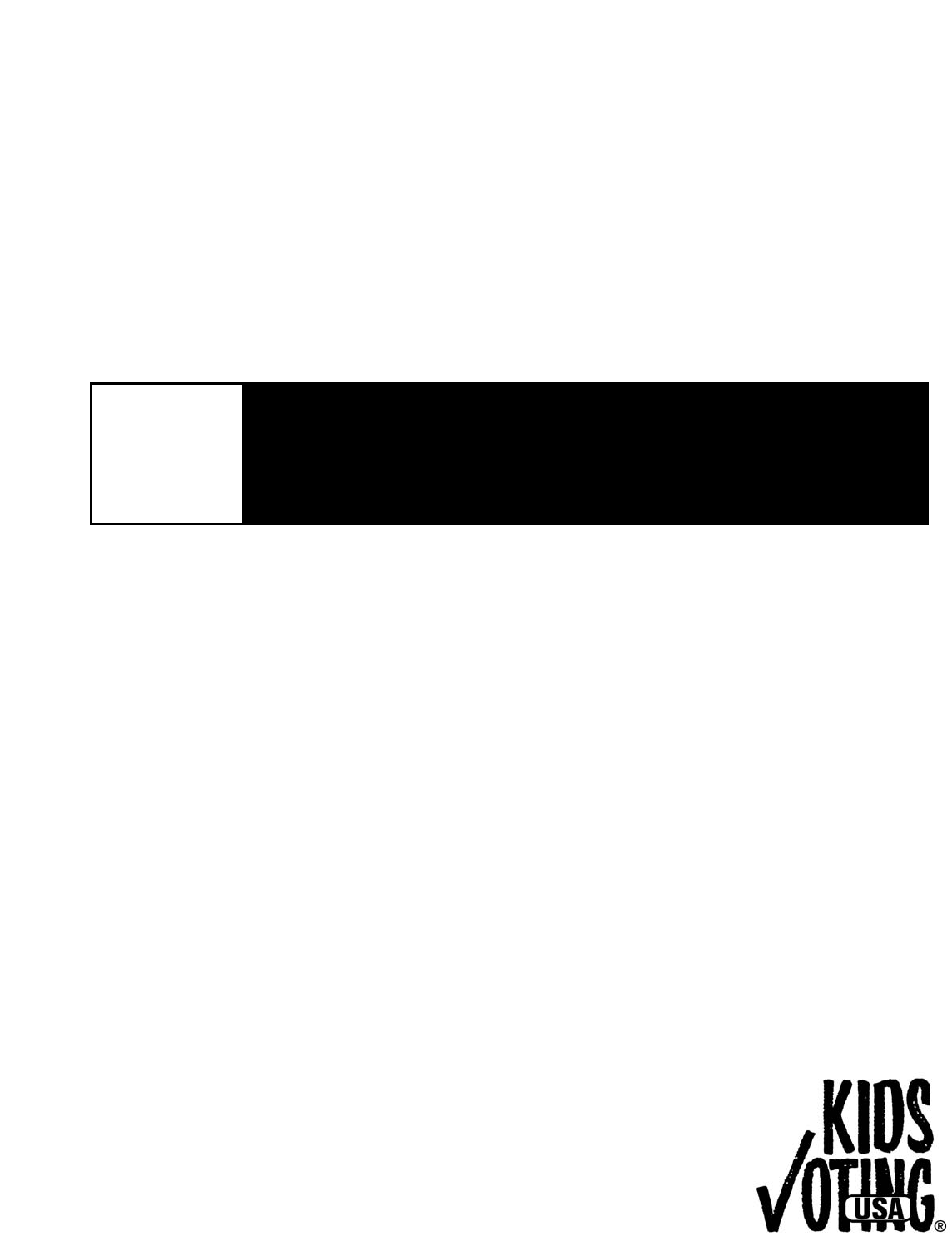
DEMOCRACY AND
THE PEOPLE
KIDS VOTING USA
K–2

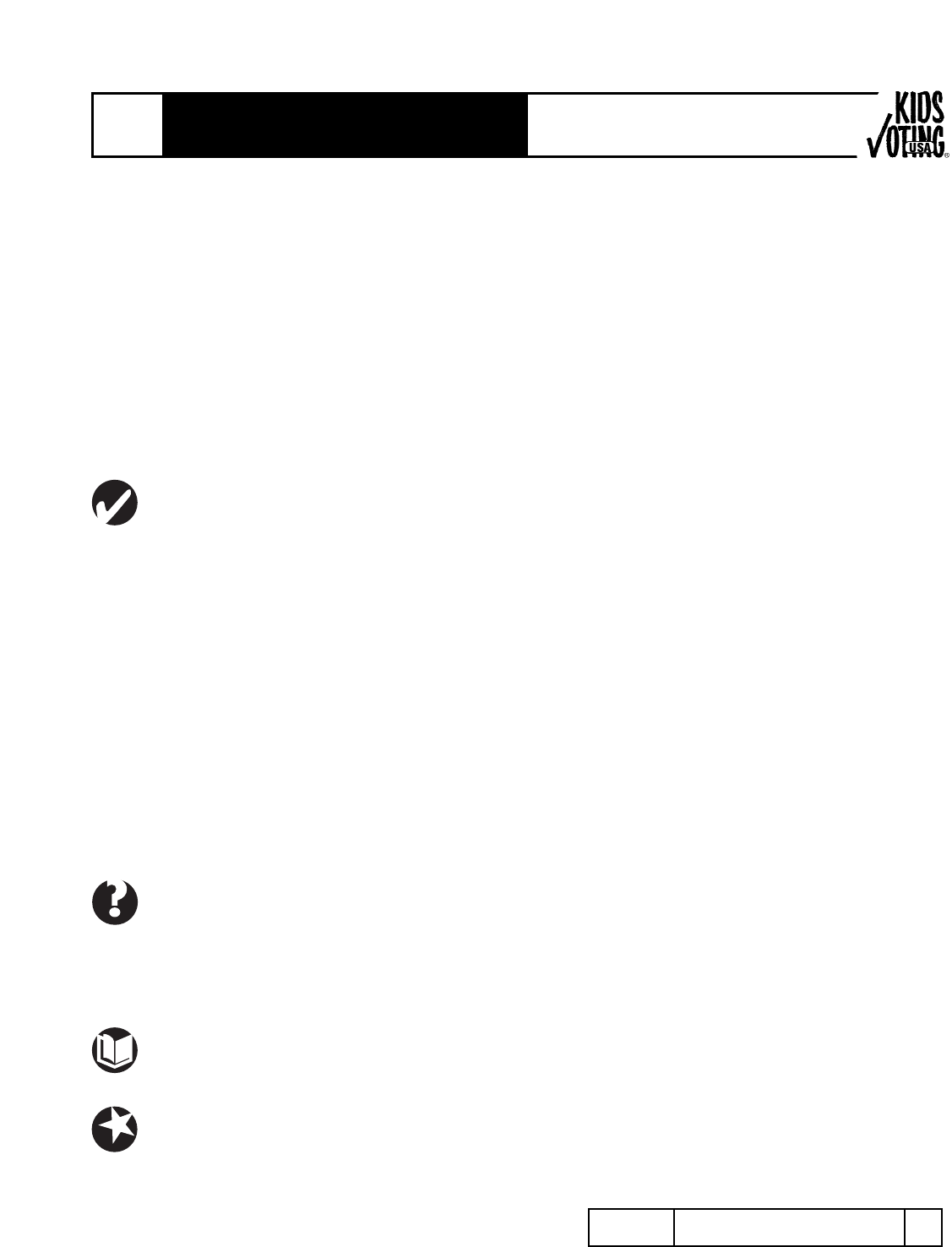
1DEMOCRACY AND THE PEOPLEGrades K-2
©2005 Kids Voting USA, Inc. – All rights reserved.
K–2
DEMOCRACY AND THE PEOPLE
INTRODUCTION TO THEME
The intent of this theme is to provide an understanding of and a context for American democracy and
citizenship, from the rights and responsibilities of students in their local, state, and national communities to
the world beyond. The theme’s activities fall under four main learning objectives:
• Students will understand the principles that make a government democratic.
• Students will understand how America fits the model of a democracy.
• Students will learn the rights and responsibilities of an American citizen.
• Students will learn the context of American democracy within the world.
GENERAL ACTIVITIES
CONCEPT 1: WHAT IS DEMOCRACY?
Pinwheels . . . . . . . . . . . . . . . . . . . . . . . . . . . . . . . . . . . . . . . . . . . . . . . . . . . . . . . . . . . . . . . . . . . . . 2
Who’s The Leader? . . . . . . . . . . . . . . . . . . . . . . . . . . . . . . . . . . . . . . . . . . . . . . . . . . . . . . . . . . . . . . 4
CONCEPT 2: DEMOCRACY IN AMERICA
The President’s Hats . . . . . . . . . . . . . . . . . . . . . . . . . . . . . . . . . . . . . . . . . . . . . . . . . . . . . . . . . . . . 5
If I Were… . . . . . . . . . . . . . . . . . . . . . . . . . . . . . . . . . . . . . . . . . . . . . . . . . . . . . . . . . . . . . . . . . . . 9
What’s For Kids? . . . . . . . . . . . . . . . . . . . . . . . . . . . . . . . . . . . . . . . . . . . . . . . . . . . . . . . . . . . . . . 11
CONCEPT 3: A CITIZEN’S RIGHTS AND RESPONSIBILITIES
Car-Car . . . . . . . . . . . . . . . . . . . . . . . . . . . . . . . . . . . . . . . . . . . . . . . . . . . . . . . . . . . . . . . . . . . . . . 12
“I Can Vote” Song . . . . . . . . . . . . . . . . . . . . . . . . . . . . . . . . . . . . . . . . . . . . . . . . . . . . . . . . . . . . . 13
CONCEPT 4: DEMOCRACY IN THE WORLD
Friends Afar . . . . . . . . . . . . . . . . . . . . . . . . . . . . . . . . . . . . . . . . . . . . . . . . . . . . . . . . . . . . . . . . . . 15
Democracy In The Print . . . . . . . . . . . . . . . . . . . . . . . . . . . . . . . . . . . . . . . . . . . . . . . . . . . . . . . . 16
OVERARCHING QUESTIONS
Questions for Concept 1: What is Democracy? . . . . . . . . . . . . . . . . . . . . . . . . . . . . . . . . . . . . . . . . . . .17
Questions for Concept 2: Democracy in America . . . . . . . . . . . . . . . . . . . . . . . . . . . . . . . . . . . . . . . . . 17
Questions for Concept 3: A Citizen’s Rights and Responsibilities . . . . . . . . . . . . . . . . . . . . . . . . . . . . 17
Questions for Concept 4: Democracy in the World . . . . . . . . . . . . . . . . . . . . . . . . . . . . . . . . . . . . . . . . 17
LITERATURE CONNECTION ACTIVITY
D is for Democracy: A Citizen’s Alphabet by Elisa Grodin . . . . . . . . . . . . . . . . . . . . . . . . . . . . . . . . . . 18
CULMINATING ACTIVITY
Democracy And Me . . . . . . . . . . . . . . . . . . . . . . . . . . . . . . . . . . . . . . . . . . . . . . . . . . . . . . . . . . . . . . . . . 19

2DEMOCRACY AND THE PEOPLEGrades K-2
©2005 Kids Voting USA, Inc. – All rights reserved.
K–2
DEMOCRACY AND THE PEOPLE
What is Democracy?
OBJECTIVE
Students discuss how a democracy is powered
by the people that participate in it.
MATERIALS
Pinwheels Pattern handout; fasteners, hole
punchers, scissors, crayons/markers;
plastic straws
GET READY
Copy a pinwheel pattern for each student.
Set out fasteners for each student.
Gather a hole puncher, scissors, and crayons
or markers.
Buy plastic straws, flatten them at one end,
and punch a hole to use them for stems.
INSTRUCTIONS
Instruct your students to decorate their
pinwheels as they wish. Then tell them to cut
on the heavy lines of the pattern and fold on
the lines as indicated.
Help them stick the fasteners through the
pinwheels and the stems. Be sure they keep
the fasteners loose enough so the pinwheels
will turn.
Ask your students to hold the pinwheels still
(without blowing on them) to see if they turn.
Then ask them to power the pinwheels by
blowing on them.
Suggest to your class that the pinwheels and
our government are alike in that they both
need a source of power.
DISCUSSION QUESTIONS
# Did the pinwheels turn without your power?
# Does the government work without our power?
# We power the pinwheels with our breath. How
do we power our government? (With our vote,
by running or helping someone else run for
office, writing letters, serving on committees,
paying our taxes, etc.)
MORE!
Use fluorescent crayons and a black light on
the pinwheels. Also, have your students vote
on an issue that can be implemented quickly
so they can feel the power their vote gives
them. Possible issues might be room arrange-
ment, recess game, a class assignment, etc.
PINWHEELS
(20-30 minutes)
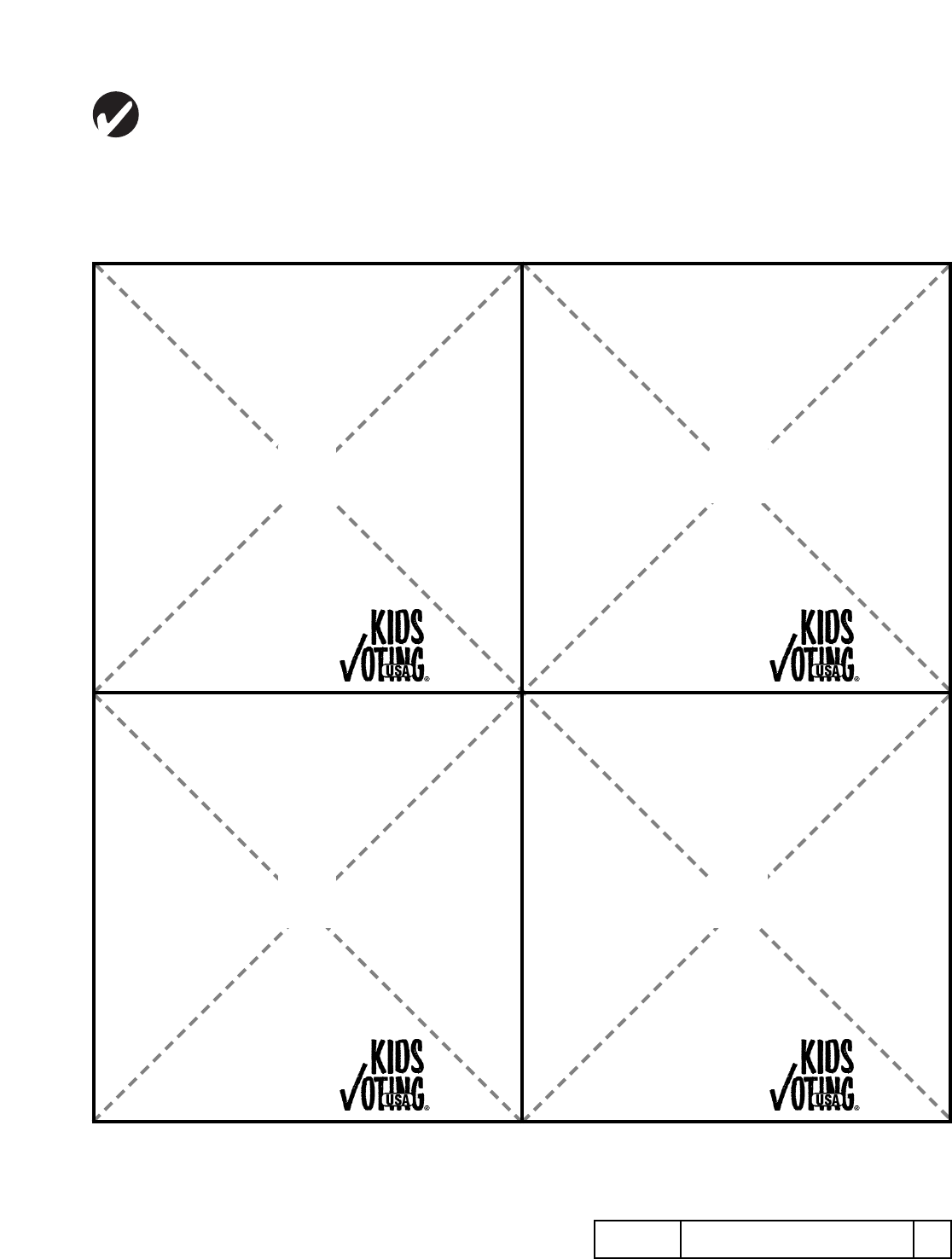
3DEMOCRACY AND THE PEOPLEGrades K-2
©2005 Kids Voting USA, Inc. – All rights reserved.
PINWHEELS
PINWHEELS PATTERN

4DEMOCRACY AND THE PEOPLEGrades K-2
©2005 Kids Voting USA, Inc. – All rights reserved.
K–2
DEMOCRACY AND THE PEOPLE
What is Democracy?
OBJECTIVE
Students identify leaders that direct or guide us.
MATERIALS
No materials are necessary for this activity.
GET READY
Say to your students, Before I became a
teacher, I studied so I could better help you
learn. In a democracy, our leaders study the
problems of our country so they can help us
solve them.
Say, In democracies we have leaders who make
decisions. They are allowed to make these
decisions, however, only because we gave them
the permission.
Say, We are going to play a game about
leadership.
INSTRUCTIONS
Have your students stand in a circle.
Have one student volunteer to briefly stand
outside the room (so they don’t know what the
class is doing).
Select another student to be the leader.
Tell the leader to make motions such as
moving hands, tapping feet, nodding head, etc.
Instruct the other students to do whatever the
leader does. Call the volunteer student back in
the room.
Ask the volunteer student to stand in the
center of the circle, attentively watch his/her
classmates, and try to identify the leader. When
the student discovers the leader, start the game
over with two new students.
DISCUSSION QUESTIONS
# What was the leader’s role in this game?
# What do the leaders of our community, our
state, and our country do?
# Can you name some leaders in your home,
school, or community?
# Were you ever a leader before you played
this game?
# Have you ever followed a leader?
# Are there certain ways leaders should act?
What makes a good leader?
VOTE QUOTE
“The whole of government consists in the art
of being honest.” – Thomas Jefferson
WHO’S THE LEADER?
(15-20 minutes)

5DEMOCRACY AND THE PEOPLEGrades K-2
©2005 Kids Voting USA, Inc. – All rights reserved.
K–2
DEMOCRACY AND THE PEOPLE
Democracy in America
OBJECTIVE
Students examine the jobs of the president to
discuss components of American democracy.
MATERIALS
The Hat Patterns handout; The President’s
Work handout; small boxes
GET READY
Copy and cut apart The Hat Patterns handout.
Place each hat on the front of an open box.
Divide your class into groups of three.
Copy and cut apart a set of The President’s
Work cards for each group of three.
Read “The Office of President” in the Appendix.
INSTRUCTIONS
Prepare your class for the activity with a
discussion about the powers and duties of the
president and define any words that might be
new to them. Specifically, go over what the job
titles mean: head of state, chief diplomat, etc.
Give each group a set of cards.
Instruct each group to discuss each card,
decide which responsibility goes to which hat/
job, and place the cards in the correct hat box.
When all the cards are in the hat boxes, tell
your students that they are going to see what
everyone else thought.
Invite students to draw the cards out of the boxes.
You can keep track by posting them on the board
or by taping them to the front of the boxes.
Go over which duties belonged to each job:
Answers:
Head of State: Officially visits other
countries
Chief Diplomat: Helps settle problems
among other countries
Chief Executive: Carries out laws
Commander-in-Chief: Defends country
during war
Party Chief: Heads political party
DISCUSSION QUESTIONS
# What do you think is the most important job
of the president? Why?
# Which hat would you like to wear? Why?
# Which hat would you not like to wear? Why?
# What characteristics do you think a president
should have?
MORE!
Develop a similar activity for the governor
or mayor.
THE PRESIDENT’S HATS
(20 minutes)
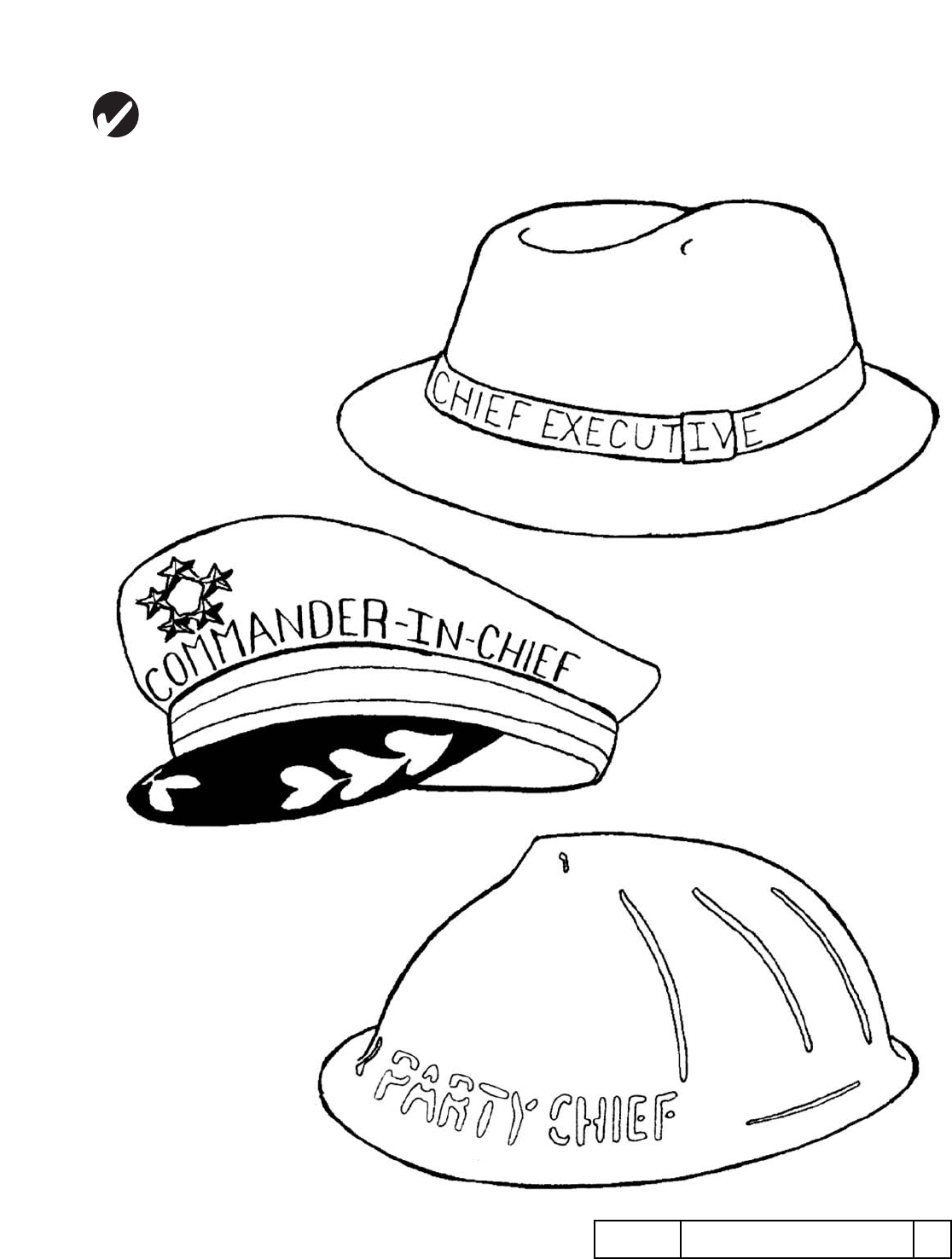
6DEMOCRACY AND THE PEOPLEGrades K-2
©2005 Kids Voting USA, Inc. – All rights reserved.
THE HAT PATTERNS
THE PRESIDENT’S HATS
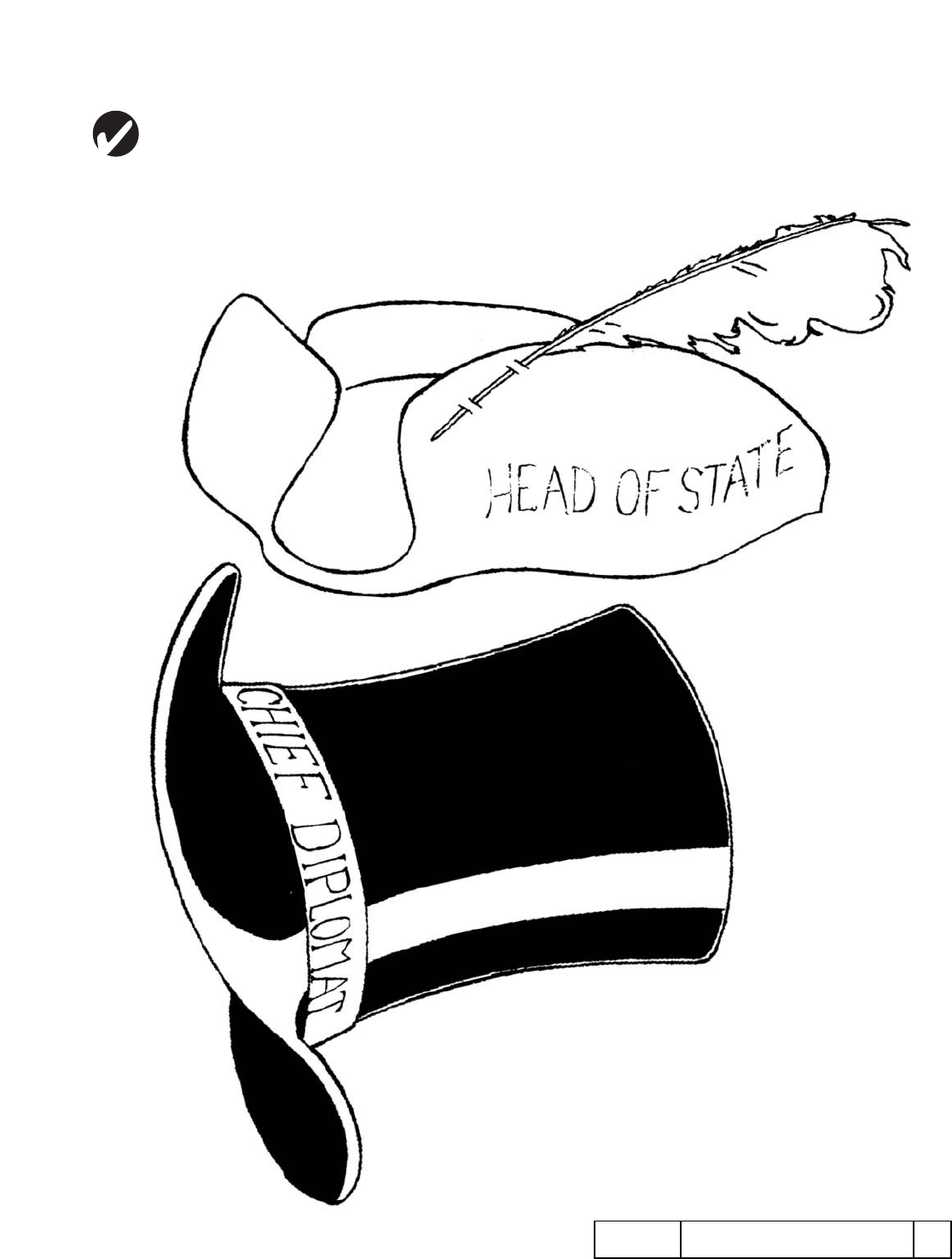
7DEMOCRACY AND THE PEOPLEGrades K-2
©2005 Kids Voting USA, Inc. – All rights reserved.
THE HAT PATTERNS
THE PRESIDENT’S HATS
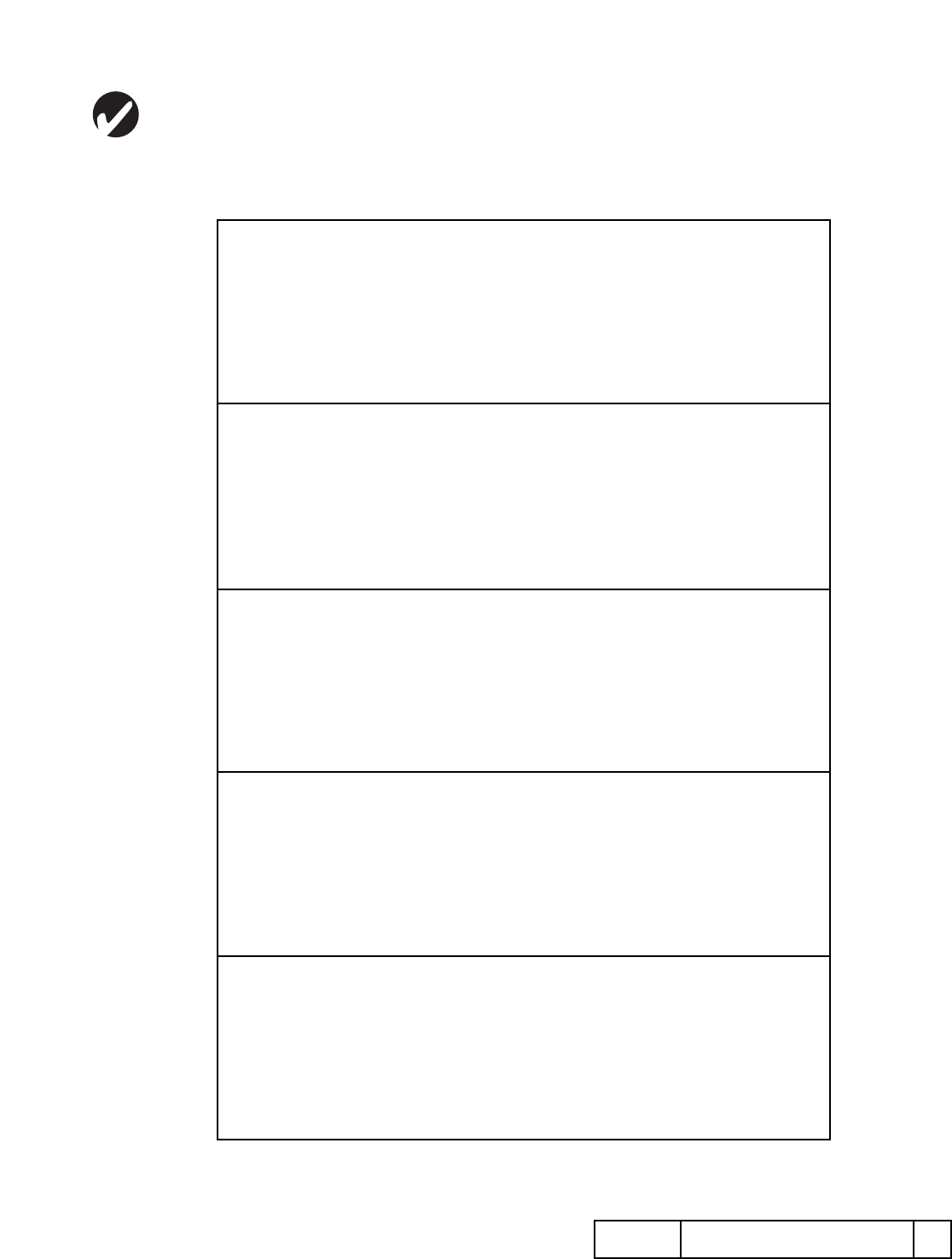
8DEMOCRACY AND THE PEOPLEGrades K-2
©2005 Kids Voting USA, Inc. – All rights reserved.
THE PRESIDENT’S WORK
THE PRESIDENT’S HATS
HEADS POLITICAL PARTY
HELPS SETTLE PROBLEMS
AMONG OTHER NATIONS
CARRIES OUT LAWS
DEFENDS THE COUNTRY
DURING WAR
OFFICIALLY VISITS
OTHER COUNTRIES

9DEMOCRACY AND THE PEOPLEGrades K-2
©2005 Kids Voting USA, Inc. – All rights reserved.
K–2
DEMOCRACY AND THE PEOPLE
Democracy in America
OBJECTIVE
Students consider the power of American
democracy in action, making decisions as an
elected leader would.
MATERIALS
If I Were… handout; additional lined paper;
scissors, glue
GET READY
Copy an If I Were… handout for each student.
If possible, use colored paper.
Have additional paper available for students to
write on.
INSTRUCTIONS
Ask, In America can our leaders do whatever
they want? Listen to student responses.
Next, ask, What types of leaders do we have in
America? (president, vice president, governor,
senator, etc.) What are the jobs of these
leaders?
Tell your students to imagine they were just
elected to office. Ask, What office would you
want to hold? Governor? Senator? Mayor?
President?
Provide each student with an If I Were…
handout. Tell them to use this handout to
brainstorm ideas of what they would do if
elected to office.
Allow your students to write their ideas on the
handout. You can have the students work with
each other to come up with ideas.
Students can additionally cut out the position
they want from the handout and either glue or
tape it to what they write (see handout).
Allow students to share their work.
DISCUSSION QUESTIONS
# What were some of the best ideas that we
heard?
# Did the ideas sound like they would be good
for everyone? (Remember, leaders need to do
their best for everyone.)
# Think about the office you wrote about.
Can you name a power this leader has?
# Could you actually become this leader?
What could you do to become a good leader?
IF I WERE…
(20 minutes)
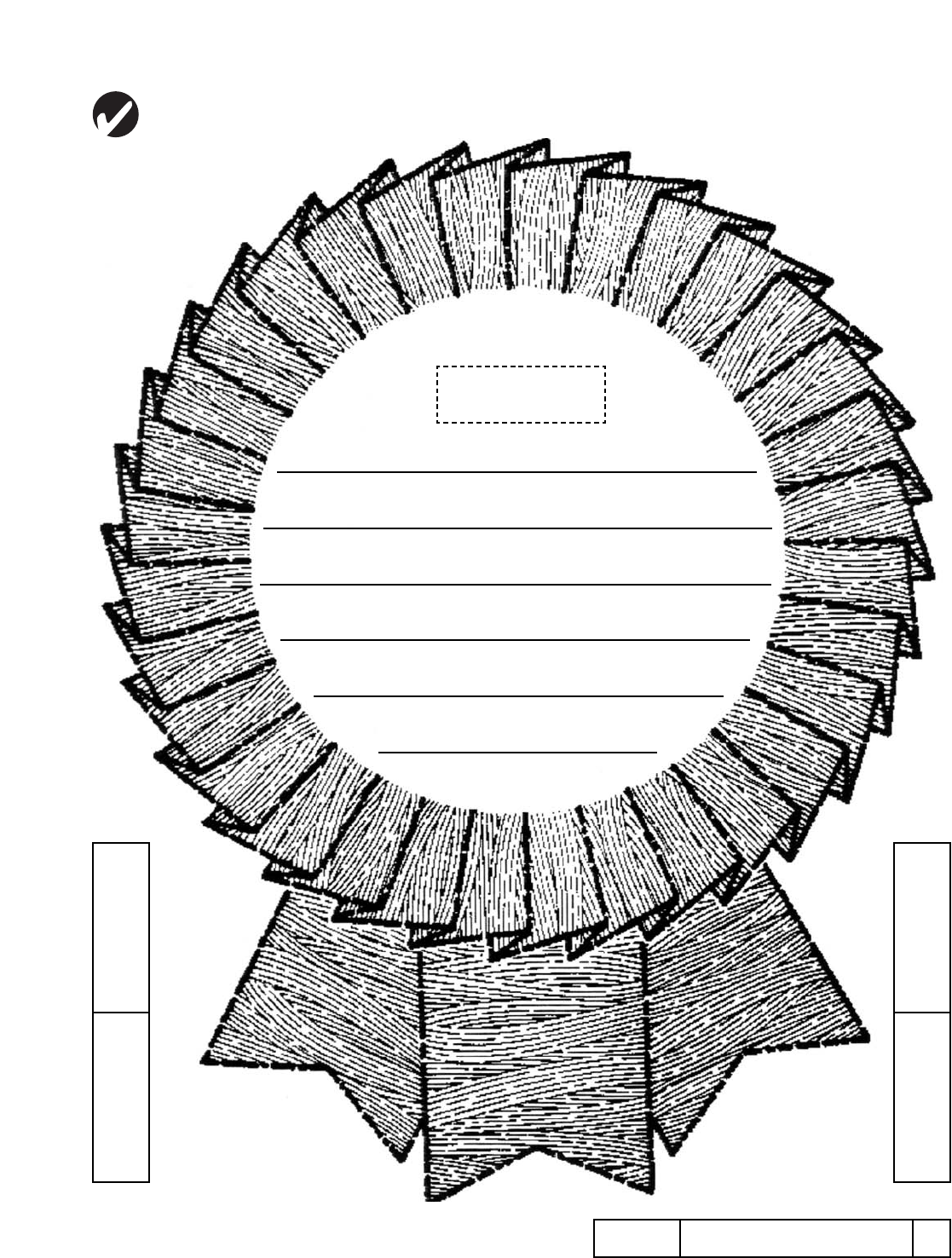
10DEMOCRACY AND THE PEOPLEGrades K-2
©2005 Kids Voting USA, Inc. – All rights reserved.
IF I WERE…
IF I WERE…
Governor Mayor
President Senator

11DEMOCRACY AND THE PEOPLEGrades K-2
©2005 Kids Voting USA, Inc. – All rights reserved.
K–2
DEMOCRACY AND THE PEOPLE
Democracy in America
OBJECTIVE
Students investigate the services provided
directly to children by their government.
MATERIALS
Telephone book; drawing paper, markers, crayons
GET READY
Consult the telephone book’s government
pages to write down the names of programs in
your town which provide services directly for
children: Parks and Recreation, Pools,
Museums, Libraries, Bicycle Registration, etc.
Post these on your board.
Gather sheets of paper, crayons, and markers.
INSTRUCTIONS
Say, In America, our government plans and
organizes activities and services for the
children in our communities.
Point out to your students that they take
advantage of city services in many ways. Ask,
Who has a library card? Who plays in the
park? Who is part of a soccer league?, etc.
Ask each student to choose a city service
he/she likes to use and to draw a picture of
him/her using the service. (Examples:
swimming in the city pool, reading books at
the library, visiting the children’s museum, etc.)
Instruct your students to share their drawings
with each other.
DISCUSSION QUESTIONS
# Did any two or three people choose the same
city service?
# How does the town pay for the swimming
pool, library, soccer field, etc.?
# How does voting affect city services for kids?
MORE!
Invite the director of parks and recreation or
the museum or library director to speak to
your class about programs for children.
WHAT’S FOR KIDS?
(20 minutes)
Thanks to former Tempe, Arizona Mayor Neil Giuliano for assistance with this lesson.

12DEMOCRACY AND THE PEOPLEGrades K-2
©2005 Kids Voting USA, Inc. – All rights reserved.
K–2
DEMOCRACY AND THE PEOPLE
A Citizen’s Rights and Responsibilities
OBJECTIVE
Students practice being responsible and
articulate their responsibility to vote.
MATERIALS
No materials are necessary for this activity.
GET READY
Arrange to work in a room with a large open
space.
INSTRUCTIONS
Explain to your students that they are going
to play a game in which they need to be
responsible.
Help your students pair off and decide who will
be the drivers and who will be the cars.
Ask the drivers to stand behind the cars with
their hands on the cars’ shoulders.
Have the cars shut their eyes.
Tell the drivers to steer their cars by pulling
gently, with their hands, on the cars’ shoulders.
Instruct the drivers to begin when you say “green
light” and to stop when you say “red light.”
Play for a few minutes, and then have the pairs
change positions.
DISCUSSION QUESTIONS
# What does it mean to be responsible?
# What were the drivers responsible for?
# What were the cars responsible for?
# What happened if one person was not
responsible?
# Why should people be responsible to vote?
# Why should people be responsible in
everything they do?
# What can happen if people are not responsible?
MORE!
Suggest to your students that they play this
game and talk about responsibility with those
at home.
VOTE QUOTE
“Politics is just another word for your future.”
– Unknown
CAR-CAR
(15 minutes)

13DEMOCRACY AND THE PEOPLEGrades K-2
©2005 Kids Voting USA, Inc. – All rights reserved.
K–2
DEMOCRACY AND THE PEOPLE
A Citizen’s Rights and Responsibilities
OBJECTIVE
Students recognize that voting is a right and
privilege that makes a difference.
MATERIALS
“I Can Vote” Song handout
GET READY
Either learn the song yourself or find someone
to teach it to your class.
INSTRUCTIONS
Teach your class the song.
Use it in a program with hand movement
and marching.
Help your students make red, white, and blue
decorations.
Have your students wear red, white, and blue.
Have your class perform for their parents/
guardians or for the school.
DISCUSSION QUESTIONS
# What makes America a special place to live?
# Does one vote make a difference? Why?
# Can kids make our country better? How?
“I CAN VOTE” SONG
(15 minutes)
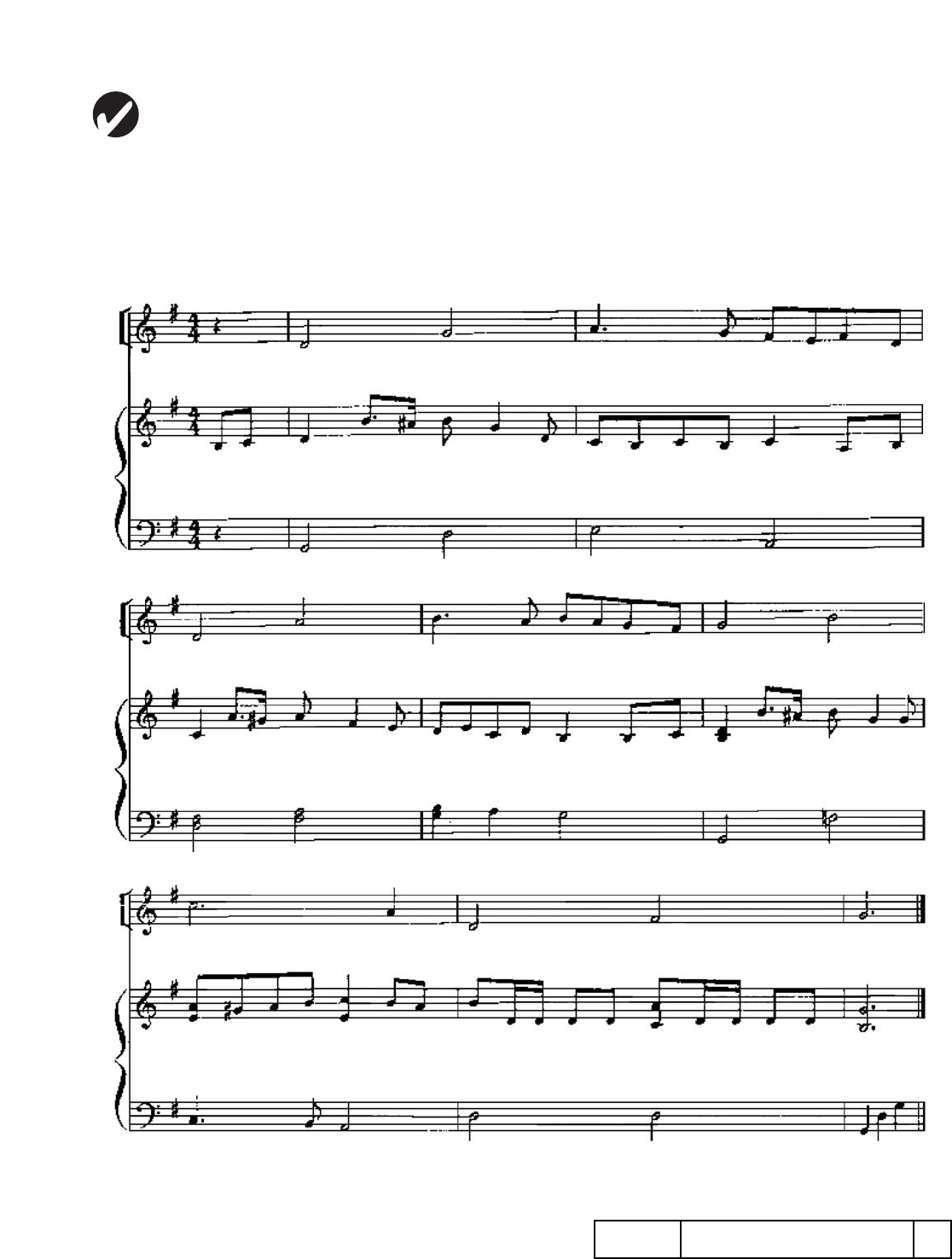
14DEMOCRACY AND THE PEOPLEGrades K-2
©2005 Kids Voting USA, Inc. – All rights reserved.
“I CAN VOTE” SONG
I Can Vote
“I CAN VOTE” SONG
Brightly Words & Music by
Cathy P. Shepherd
© Copyright 1992 All Rights Reserved Cathy P. Shepherd
1558 W. 1st St., Mesa, Arizona (602) 962-4759
Optional descant I can vote. I’ll make a diff - ‘rence
1. I am young and I’m learn - ing a - bout the world I see, I am
2. I am one, just one per - son but one and one make two. You will
with my vote, you’ll see the diff - ’rence. I am
us - ing my know - ledge to make a bet - ter me. I can help keep my coun - try free
see what a diff - ‘rence that one or two can do. When you mul - ti - ply peo - ple the
young but I can vote.
keep its lib - er - ty. I will stand for the right and vote wise and care - ful - ly.
won - ders nev - er cease, As we build for the fu - ture, work - ing to keep our peace.

15DEMOCRACY AND THE PEOPLEGrades K-2
©2005 Kids Voting USA, Inc. – All rights reserved.
K–2
DEMOCRACY AND THE PEOPLE
Democracy in the World
OBJECTIVE
The class contacts students overseas to learn
about a different country.
MATERIALS
Appropriate letter-writing materials: lined
paper, pens/pencils, envelopes, etc.
GET READY
Arrange for a pen pal from another country to
exchange information about their country.
Write to: World Wise Schools
990 K Street N.W.
Washington, D.C. 20526.
Look for pen pal opportunities on the
Internet. A good Web site to visit is
www.stonesoup.com/main2/penpal.html.
INSTRUCTIONS
As a class, correspond with a class from
another county.
Have your students brainstorm some questions/
ideas that they want to include in their letters.
Encourage your students to ask questions:
How is your country different from the United
States? Do you know people who vote? How
old do you have to be to vote? What is the
name of your current leader?
Continue to correspond with this class
throughout the school year.
DISCUSSION QUESTIONS
# How is our government similar to other
countries’ governments?
# How is it different?
# What did you learn that you liked most about
the other country?
# Were there any things you did not like?
FRIENDS AFAR
(Time varies)

16DEMOCRACY AND THE PEOPLEGrades K-2
©2005 Kids Voting USA, Inc. – All rights reserved.
K–2
DEMOCRACY AND THE PEOPLE
Democracy in the World
OBJECTIVE
Students explore aspects of another democracy.
MATERIALS
Newspapers, magazines, periodicals; scissors
GET READY
Tell your students that there are other
democracies in the world besides the United
States. In fact, there are many countries where
people have the right to vote.
Inform your class that they are going to learn
about another democratic country.
INSTRUCTIONS
Tell your class they are going to collect
information on another democratic country.
Have your students vote to decide what
country they want to learn about. Provide
some ideas if necessary: France, Australia, etc.
Once the class has chosen a country, start
collecting magazines and newspapers that
contain articles and pictures about the
country. If at all possible, find articles that are
written for children.
Dedicate a bulletin board in the classroom to
the articles and pictures.
Bring these magazines and newspapers into
school and show your students how you found
the articles. Show them how you cut them out
and attached them to the bulletin board.
Read aloud what some of the articles say and
explain what some of the pictures show. Make
connections between the country the class
selected and America — explain how the
country is a democracy.
Encourage your students to bring in any
materials they can find on the country. They
may want to ask their parents/guardians for
help finding these items.
Give your students time to make a
contribution (it may take some time for them
to find appropriate/related material). Announce
intermittently any updates to the bulletin board.
DISCUSSION QUESTIONS
# What makes the country we learned about
a democracy?
# How is this country like the United States?
# How is this country different than the
United States?
DEMOCRACY IN THE PRINT
(30-40 minutes)

17DEMOCRACY AND THE PEOPLEGrades K-2
©2005 Kids Voting USA, Inc. – All rights reserved.
K–2
DEMOCRACY AND THE PEOPLE
WHAT IS DEMOCRACY?
# Have you heard the word “democracy” before? Where and when?
# Do you know what a government is?
# Who has the power in a democracy? The leader or the people he/she leads?
# How are decisions made in a democracy?
# Sometimes people don’t agree with the decisions that are made. Should everyone still have to
stand by those decisions? Why or why not?
# If you did not live in a democracy, what do you think you would be missing?
# How can you, as students, participate in a democracy?
# Does everyone you know understand what a democracy is? What can you do to help others
understand democracy?
DEMOCRACY IN AMERICA
# Who makes the decisions in America?
# What do adults do to contribute to our country?
# What does our government do for us?
# How do you support your country?
# What can you do to make our country better?
# What types of people make good leaders? Good presidents?
# What do you think is the best thing about living in America?
A CITIZEN’S RIGHTS AND RESPONSIBILITIES
# Do you know what it means to be responsible?
# How are you responsible? Give me an example.
# What does having a right mean?
# Can you think of an example of a right?
# What do you think the freedom of speech is?
# What does the word “freedom” mean to you?
# Do you think kids have enough rights?
DEMOCRACY IN THE WORLD
# Can you tell me the names of some other countries?
# Do you think all countries are the same?
# What do you think are some differences between countries?
# Can you give a reason why many countries have become democracies?
# Why do you think so many people from other countries want to live in America?
OVERARCHING QUESTIONS

18DEMOCRACY AND THE PEOPLEGrades K-2
©2005 Kids Voting USA, Inc. – All rights reserved.
K–2
DEMOCRACY AND THE PEOPLE
OBJECTIVE
Students understand the concept of democracy
and how it applies to America.
MATERIALS
D is for Democracy: A Citizen’s Alphabet -
Elisa Grodin
PRE-READING ACTIVITY
Tell your students that they will be learning
about democracy. Explain that a democracy is
a government where all citizens have a voice.
Let your students know that each letter of the
alphabet is represented in this book by a word
that has something to do with democracy. For
example, W is for George Washington.
Have your students guess what the different
letters stand for. Don’t reveal what they
actually stand for until someone guesses
correctly. Remind your students that all their
guesses need to be about democracy in America.
DISCUSSION QUESTIONS
# What do you think were some of the most
important words discussed in the book? Why
do you think those words are so important?
# How would you describe a democracy?
# How is America a democracy?
# What can you do to make sure your voice is
heard?
# The last pages of the book say, “We Want You
To Get Involved?” Involved in what? What do
they mean?
ACTIVITY
Play a memory game with your students. After
reading them the book (you may want to read
it for a second time before you play), ask your
students to recall each page’s key word.
Go alphabetically through the book saying, A
was for… B was for… letting your students
finish the statements.
Cover the key words on each page (so the
students don’t see it) and make sure you hold
up the pictures for your students to see. The
pictures on each page should jog their
memories, but you can always give clues such
as, No “D” is not for dog, “D” is for our type of
government.
Keep the book available in your classroom and
encourage your students to look at it when
they get a chance.
Consider playing the memory game again after
some time has passed.
LITERATURE CONNECTION ACTIVITY
D is for Democracy: A Citizen’s Alphabet
by Elisa Grodin, Illustrated by Victor Juhasz

19DEMOCRACY AND THE PEOPLEGrades K-2
©2005 Kids Voting USA, Inc. – All rights reserved.
K–2
DEMOCRACY AND THE PEOPLE
OBJECTIVE
Students learn the characteristics of a
democratic society and how they can improve
where they live.
MATERIALS
Ways I Can Participate in Our Democracy
handout
GET READY
Copy the Ways I Can Participate in Our
Democracy handout so you have a copy for
each student or make a transparency of it for
an overhead projector.
INSTRUCTIONS
Ask students, How many have heard of the
word “democracy”? Does anyone know what it
means? What other words do you think of
when you hear “democracy”? List your
students’ ideas on the board.
Read to your students the following definition:
A democracy is a society where the people are
involved in making many of the decisions
about what happens.
Ask students, How do people in the United States
help make decisions about the government,
schools, laws, and other important aspects of
our lives? (Possible answers include attending
public meetings, writing letters to public
officials, running for public office, and serving
on a local board. If students do not mention
voting, make sure to tell them that it’s one of
the major ways citizens help make decisions).
Ask students, Is democracy just for grown-ups?
Does it have anything to do with kids? Accept all
responses. Then ask, How many of you ride a
bike? Wear pajamas? Use a local park? Drink
water? Breathe the air? Explain to your students
that the laws made by our local, state, and
federal governments determine what is acceptable
and what isn’t with these and many other
situations. The government affects most of our
everyday activities, including the fact that students
are required, at this moment, to be in school!
Use the Ways I Can Participate in Our
Democracy handout on an overhead projector
and ask students to identify the things that
kids can do to participate in our democracy.
Have a discussion with the class after
completing the handout. Are your students
surprised that they can contribute to our
democracy in so many ways? While elementary
school students are not old enough to vote,
they can still influence how adults vote and
otherwise contribute to improving society.
(Instead of using an overhead projector, you
can copy the handout for individuals or
groups, depending on their reading abilities.)
After completing the handout, ask your
students to choose a class activity. (Have your
students vote by ballot or by a show of hands.)
The class should come up with a plan to carry
out one of the ideas on the handout: recycling,
donating food, etc.
The class should carry out this plan and document
it with photos and writings. The class can create
a bulletin board showcasing the work they did.
CULMINATING ACTIVITY: DEMOCRACY AND ME
(45 minutes in class, additional time out of class)

20DEMOCRACY AND THE PEOPLEGrades K-2
©2005 Kids Voting USA, Inc. – All rights reserved.
K–2
DEMOCRACY AND THE PEOPLE
CULMINATING ACTIVITY: DEMOCRACY AND ME (continued)
DISCUSSION QUESTIONS
# What is a democracy?
# Can anyone share how they participate in our
democracy?
# Do you think we made a difference in our
community? How?
# Do you think it is our responsibility to help
our community? Why?
# What other ways will you be able to participate
in our democracy when you are an adult?

21DEMOCRACY AND THE PEOPLEGrades K-2
©2005 Kids Voting USA, Inc. – All rights reserved.
DEMOCRACY AND ME
WAYS I CAN PARTICIPATE IN OUR DEMOCRACY
Directions: Circle the ideas listed below that are ways kids can help their community.
Picking up trash Writing to an elected official
Following the laws Voting in public elections
Listening to or reading the news Donating money
Attending a public meeting Talking to an adult about voting
Visiting someone who is lonely Writing a letter to a newspaper
Talking to friends about a Calling the mayor about a
community problem community problem
Speaking at a public meeting Distributing flyers
Raising money for a good cause Making get well cards for
in the community children in the hospital
Volunteering at a nursing home Creating artwork that teaches
Donating food or clothing Recycling
Can you think of any other ways kids can participate in democracy?
Write them here…

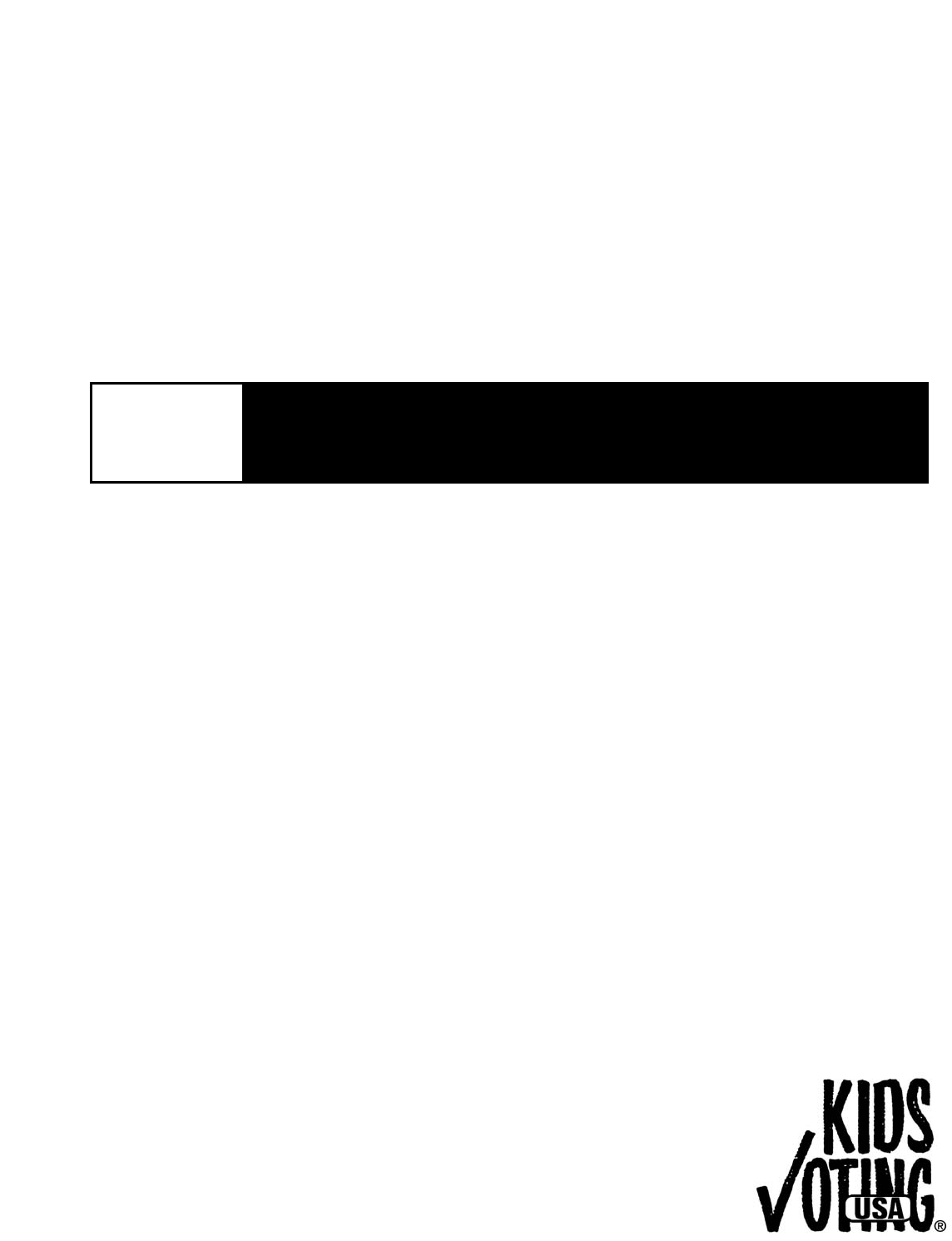
K–2
ACTIVE CITIZENSHIP
KIDS VOTING USA

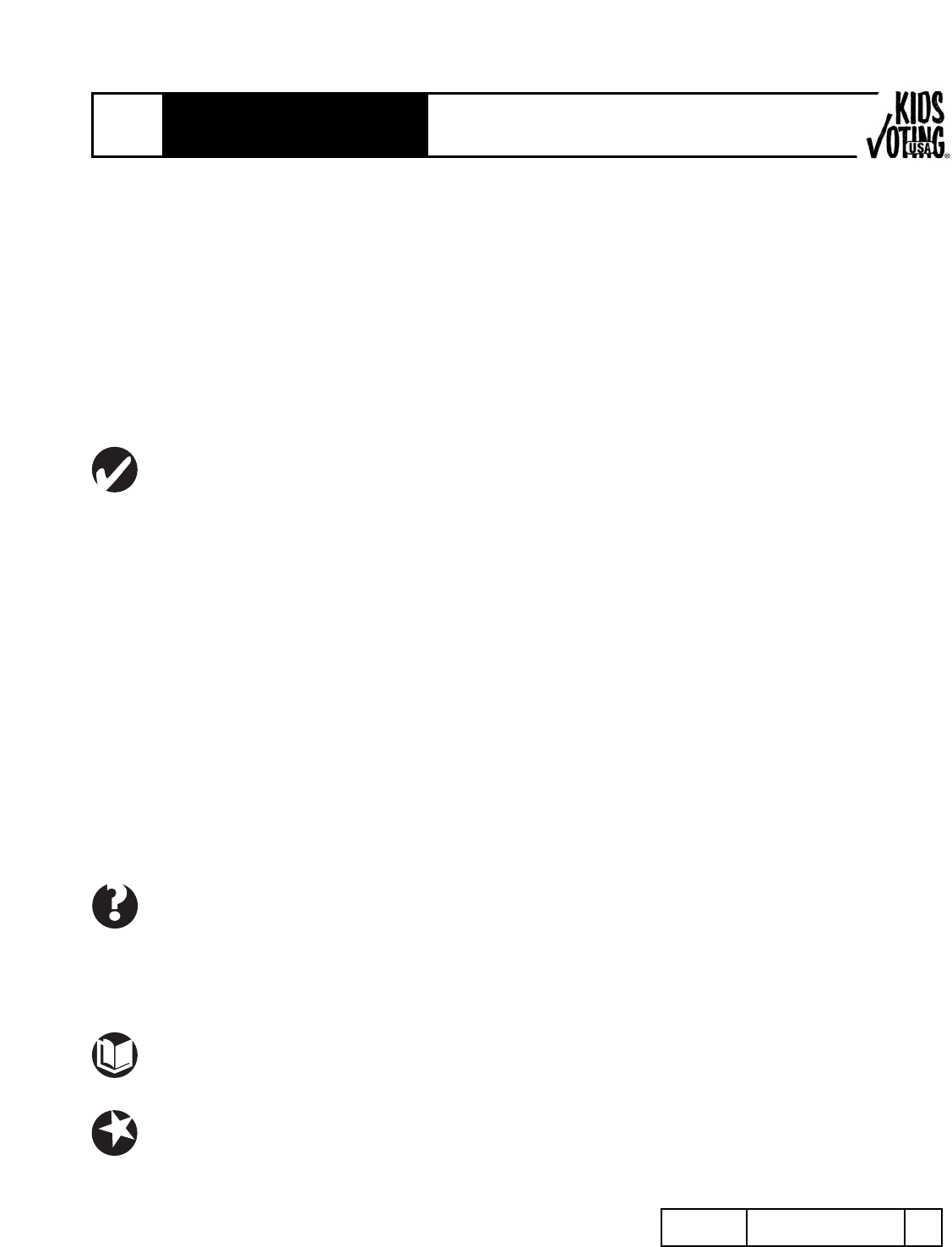
1ACTIVE CITIZENSHIPGrades K-2
©2005 Kids Voting USA, Inc. – All rights reserved.
K–2
ACTIVE CITIZENSHIP
INTRODUCTION TO THEME
The intent of this theme is for students to learn how to evaluate information and to intelligently form,
communicate, and act on the decisions they make.
The theme’s activities fall under four main learning objectives:
• Students will learn how to gather and weigh information and form an opinion.
• Students will learn how to clearly and effectively communicate their position with others.
• Students will learn how to work together effectively.
• Students will consider how they can have an impact in their community.
GENERAL ACTIVITIES
CONCEPT 1: GATHERING AND WEIGHING INFORMATION
I Heard, I Think, I Know… . . . . . . . . . . . . . . . . . . . . . . . . . . . . . . . . . . . . . . . . . . . . . . . . . . . . . . 2
Making Inferences . . . . . . . . . . . . . . . . . . . . . . . . . . . . . . . . . . . . . . . . . . . . . . . . . . . . . . . . . . . . . . 3
It’s News To Me . . . . . . . . . . . . . . . . . . . . . . . . . . . . . . . . . . . . . . . . . . . . . . . . . . . . . . . . . . . . . . . . 4
CONCEPT 2: COMMUNICATING YOUR POSITION
Robots . . . . . . . . . . . . . . . . . . . . . . . . . . . . . . . . . . . . . . . . . . . . . . . . . . . . . . . . . . . . . . . . . . . . . . . 5
Spokespeople For Kids Voting USA . . . . . . . . . . . . . . . . . . . . . . . . . . . . . . . . . . . . . . . . . . . . . . . .6
CONCEPT 3: WORKING TOGETHER
Zoo Animal Cages . . . . . . . . . . . . . . . . . . . . . . . . . . . . . . . . . . . . . . . . . . . . . . . . . . . . . . . . . . . . . . 7
Two On A Crayon . . . . . . . . . . . . . . . . . . . . . . . . . . . . . . . . . . . . . . . . . . . . . . . . . . . . . . . . . . . . . . . 8
Match Community Helpers . . . . . . . . . . . . . . . . . . . . . . . . . . . . . . . . . . . . . . . . . . . . . . . . . . . . . . . 9
CONCEPT 4: HAVING AN IMPACT
If Elected… . . . . . . . . . . . . . . . . . . . . . . . . . . . . . . . . . . . . . . . . . . . . . . . . . . . . . . . . . . . . . . . . . . 12
Postcards . . . . . . . . . . . . . . . . . . . . . . . . . . . . . . . . . . . . . . . . . . . . . . . . . . . . . . . . . . . . . . . . . . . . 14
Targeting Problems In My Community . . . . . . . . . . . . . . . . . . . . . . . . . . . . . . . . . . . . . . . . . . . . 15
OVERARCHING QUESTIONS
Questions for Concept 1: Gathering and Weighing Information . . . . . . . . . . . . . . . . . . . . . . . . . . . . . 16
Questions for Concept 2: Communicating Your Position . . . . . . . . . . . . . . . . . . . . . . . . . . . . . . . . . . . 16
Questions for Concept 3: Working Together . . . . . . . . . . . . . . . . . . . . . . . . . . . . . . . . . . . . . . . . . . . . . 16
Questions for Concept 4: Having an Impact . . . . . . . . . . . . . . . . . . . . . . . . . . . . . . . . . . . . . . . . . . . . . 16
LITERATURE CONNECTION ACTIVITY
Miss Rumphius by Barbara Cooney . . . . . . . . . . . . . . . . . . . . . . . . . . . . . . . . . . . . . . . . . . . . . . . . . . . . 17
CULMINATING ACTIVITY
What’s The Problem? . . . . . . . . . . . . . . . . . . . . . . . . . . . . . . . . . . . . . . . . . . . . . . . . . . . . . . . . . . . . . . . . 18

2ACTIVE CITIZENSHIPGrades K-2
©2005 Kids Voting USA, Inc. – All rights reserved.
K–2
ACTIVE CITIZENSHIP
Gathering and Weighing Information
OBJECTIVE
Students learn how to form opinions and make
good decisions.
MATERIALS
Magazines, books, newspapers, and/or access to
the Internet
GET READY
If your classroom is not equipped with the
Internet, find a classroom/resource room that is.
Make sure you have access to varied forms of
media: newspapers, books, etc.
INSTRUCTIONS
Setting Up the Research
Tell students that a good decision is well
thought out and based on information from
many sources. Say, Good decisions are based
on information. What are good sources of
information? (Newspapers, the Internet, books,
magazines, etc.) These are great places for
finding information on anything we want.
Ask students to brainstorm an issue or topic
that impacts their lives and that they would
like to know more about, i.e. the environment,
education, etc. Tell them they can be specific:
rainforest destruction, seat belts on school
buses, etc.
Vote to determine a subject for the class to
research.
Conducting the Research
Conduct research on the subject the class
selects. Research the topic using: books,
Internet sites, magazines, videos, etc.
Share the research in its many forms with
your students.
Say, Now that we have learned about _____,
does anyone want to share how they feel
about it (share an opinion)?
Listen to responses and encourage students to
explain why they feel the way they do (prompt
them to mention the research sources).
In the case of an election, ask students to share
why they made the decisions they have made.
DISCUSSION QUESTIONS
# How do we make good decisions?
# Why do you think it is important to gather
information from many different places?
# Can you believe everything you hear and see?
Why or why not?
MORE!
Encourage students to bring in information on
the subject as they see it in newspapers, etc.
Create a bulletin board to document the
information as it comes in.
I HEARD, I THINK, I KNOW…
(30-45 minutes)

3ACTIVE CITIZENSHIPGrades K-2
©2005 Kids Voting USA, Inc. – All rights reserved.
K–2
ACTIVE CITIZENSHIP
Gathering and Weighing Information
OBJECTIVE
Students learn to make inferences from the
information they are presented with.
MATERIALS
No materials are necessary for this activity.
GET READY
Tell the class that you can learn a lot about a
situation by the decisions people make and the
actions they take.
Tell the class that it is important to be aware of
people’s actions, especially those of our elected
officials. Give the example of a politician who
makes lots of promises to get elected but never
delivers on them. In this case, actions speak
louder than words.
INSTRUCTIONS
Tell students that they are going to play a game
similar to Charades. Explain the concept of
Charades if they are not familiar with it.
(Charades is a game played with teams. An
individual from one team “acts out” a phrase
without speaking while their teammates try to
guess what the phrase is. The objective is for
your team to guess the phrase as quickly
as possible.)
Tell students that some of them will act things
out in front of the class without talking. The
rest of the class will try to guess what the
student is acting out.
Choose student volunteers and give them
specific actions to perform in front of the class.
Choose actions that lead to rational
conclusions, such as yawning = being tired.
Give the students hints if they need help
performing their assigned actions.
Give each student about twenty seconds to act,
and then have the class guess their action.
Some other ideas for actions are:
smiling = being happy, shivering = being cold,
wiping forehead = being hot, and so on.
DISCUSSION QUESTIONS
# How were you able to make correct guesses
when everyone was acting silently?
# Why is it important to look not only at what
people say but also what they do?
# Should you base your opinions on actions
alone? Is that a smart decision, or is it better
to pay attention to both what a person says
and what they do?
# Give an example of a decision you made
recently. Say, What can you tell by the
decision I made?
MORE!
Have students come up with their own ideas to
act out silently and have the class continue to
guess what they are.
MAKING INFERENCES
(30 minutes)

4ACTIVE CITIZENSHIPGrades K-2
©2005 Kids Voting USA, Inc. – All rights reserved.
K–2
ACTIVE CITIZENSHIP
Gathering and Weighing Information
OBJECTIVE
Students learn how to distinguish the different
parts of a newspaper.
MATERIALS
Two copies of a local or national newspaper
GET READY
Obtain two copies of a local or national
newspaper.
Leave one newspaper intact and prepare to cut
the other.
Identify a few articles or advertisements from
the newspaper you have selected to cut; you
are trying to find examples of the different
components of a newspaper. For example,
locate and cut out an article from the sports
section, an article from the news section, and
also an advertisement.
Photocopy these articles so that you have
multiple sets of them. (You will be breaking your
class up into groups of three or four so make
sure to have a set of articles for each group.)
Make labels for the different newspaper
clippings. (For example, have one label say
Sports Article, another Advertisement, and one
News Article.) Make sure you have a set of
labels for each group of students as well.
If possible, laminate the labels and articles
and/or advertisements.
INSTRUCTIONS
Have a discussion with your class about news-
papers. Explain to your students why people
read them. Also make sure you describe various
newspaper components: advertisements, sports
articles, news articles (local, national and
international), travel articles, cooking articles,
and so on.
Using the newspaper you left intact, show your
class an example for each section you discuss.
For example, say, This is an advertisement
because it’s about a product that’s on sale.
This is a sports article because it’s about a
baseball game.
Break your class up into small groups of three
or four. Give each group the set of articles/
advertisements you laminated as well as the labels.
Have the groups figure out which article or
advertisement fits which label.
Go over the correct answers with your class
and ask the groups to provide explanations for
how they matched the clippings and labels.
DISCUSSION QUESTIONS
# What did you learn about a newspaper that
you didn’t know before?
# Why is it important to understand what the
different parts of a newspaper mean?
# Why do we have newspapers?
IT’S NEWS TO ME
(30 minutes)

5ACTIVE CITIZENSHIPGrades K-2
©2005 Kids Voting USA, Inc. – All rights reserved.
K–2
ACTIVE CITIZENSHIP
Communicating Your Position
OBJECTIVE
Students learn to communicate effectively
with another person.
MATERIALS
No materials are necessary for this activity.
GET READY
Tell the class that they are going to play a
game that involves good communication.
Inform the class that this activity will involve
them moving around, but there will be no
running.
Arrange for as large a space as possible.
INSTRUCTIONS
Help your students divide into pairs. Designate
one student in each pair to be the robot and
the other student to be the robot operator.
Tell the robots that they will be moving around
the room with their eyes closed. They will be
directed by their operator and may only go in a
straight line until their direction is changed by
their partner.
Tell the robot operators that they can give
directions to the robots, but cannot touch
them. For example, they can say, Go slower,
Turn left, Turn right, Turn around, etc.
Tell the robots that they should walk in place if
they hit an obstacle or another robot. They
should wait for directions from their operator
before moving again.
Give the pairs about 60 seconds to wander the
room/space as described.
Ring a bell or blow a whistle to stop all robot
action. Have the robots tell the operators one
thing they did well and one thing they could
do better next time. Then have the operators
do the same thing, and tell the robots one
thing they did well and one thing they could
do better next time.
Have your students try their roles again for an
additional 60 seconds.
Have the pairs discuss what worked better the
second time.
Next, have them swap roles: the operators take
a turn at being the robot and the robots take a
turn at being the operator.
Repeat the sequence one more time as
described above.
Finally, ask the pairs to talk about what made a
good robot and a good robot operator. After a
few minutes, open up the discussion to the
whole class.
DISCUSSION QUESTIONS
# How did it feel to be the robot operator? Was it
hard to communicate with the robots? What
made a good operator in this game?
# How did it feel to be a robot? Was it hard to
take directions from the operator? What made
a good robot in this game?
# In real life, have you ever felt anything similar
to this game? When was that? Why was it similar?
# What are some characteristics of good
communication?
# Was this game hard or easy? Why do you feel
that way?
MORE!
Suggest that the students play the game during
recess and at home. Have them ask any adults at
home what it means to be a good communicator.
ROBOTS
(20 minutes)

6ACTIVE CITIZENSHIPGrades K-2
©2005 Kids Voting USA, Inc. – All rights reserved.
K–2
ACTIVE CITIZENSHIP
Communicating Your Position
OBJECTIVE
Students advocate voting throughout their
school and community.
MATERIALS
Materials vary depending on how your students
advocate voting.
GET READY
Tell your class that they have the opportunity
to be spokespeople for Kids Voting USA.
Inform them that they will be able to share
their knowledge about voting and democracy
with the school.
INSTRUCTIONS
Ask, What messages do you want to share with
the rest of the school? How can you share
your passion for voting and democracy with
other students? How can you influence other
people to vote?
Students may come up with their own
messages as well as how to disseminate them,
but you can mention these ideas as a start:
Make posters that celebrate democracy.
Make signs to encourage classes and
students to participate in the election.
Bring in daily information for an election
bulletin board.
Visit classrooms encouraging students
to vote.
DISCUSSION QUESTIONS
# What was the message you communicated to
the school? How did you
communicate this
message (signs, posters, etc.)?
# Was it hard to convince people to vote?
If yes, what made it so hard?
# How were you best able to communicate your
message to the other students? Do you think
you were effective in sharing your message?
SPOKESPEOPLE FOR KIDS VOTING USA
(30 minutes)
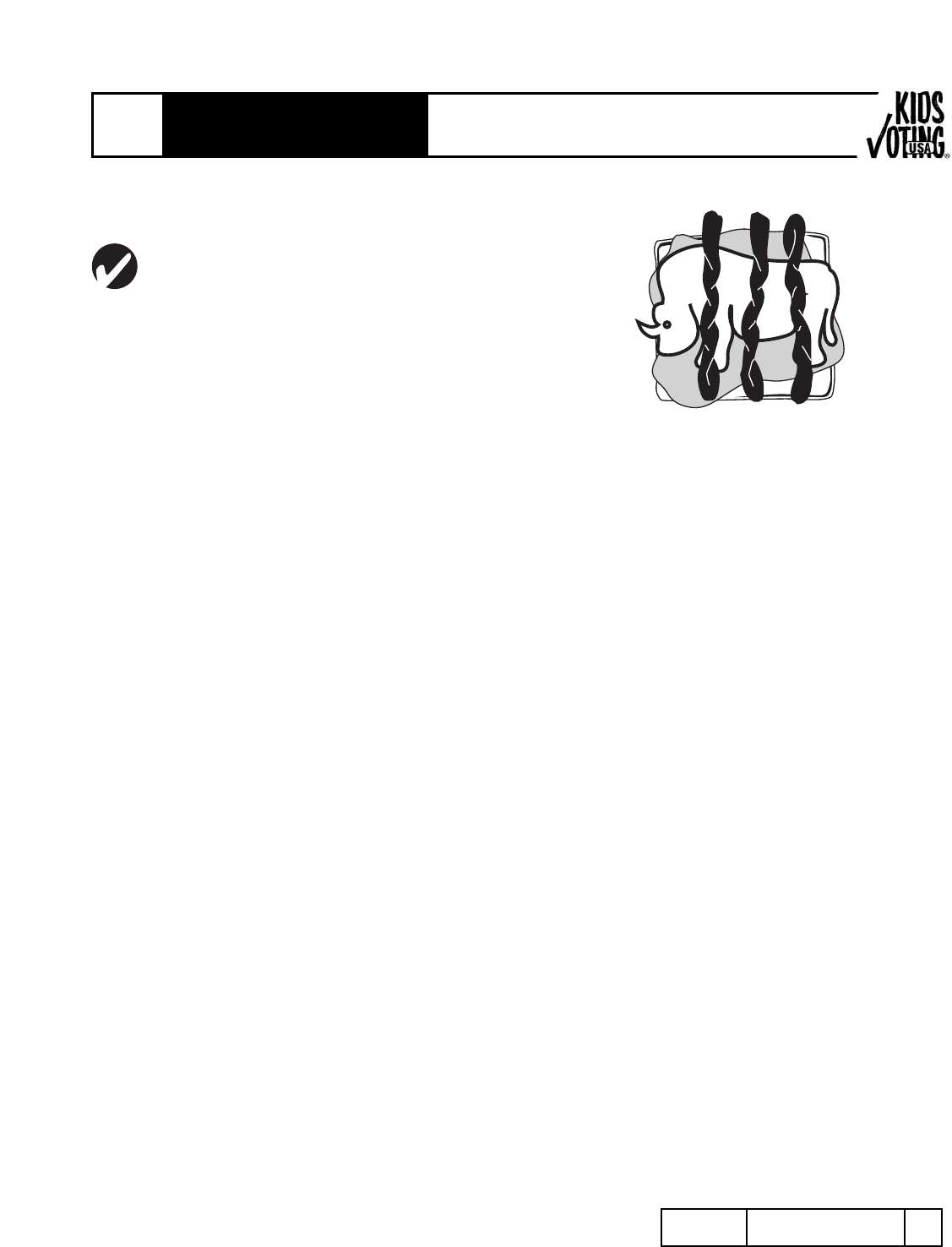
7ACTIVE CITIZENSHIPGrades K-2
©2005 Kids Voting USA, Inc. – All rights reserved.
K–2
ACTIVE CITIZENSHIP
Working Together
OBJECTIVE
Students learn to cooperate while creating
edible zoo animal cages.
MATERIALS
1 half of a graham cracker per child;
1 container (more depending on class size) of
white frosting; 1 animal cracker per child; 3
licorice/Twizzler
®
pieces per child; plastic
knives for spreading frosting
GET READY
Split your students up into groups of four.
Make sure there are enough graham crackers,
white frosting, animal crackers, and
licorice/Twizzler
®
pieces per child.
Have each child wash their hands extremely
well, as they will all be handling food.
INSTRUCTIONS
Tell your students that they will be making
treats they can eat, though they must work
together in their groups to make it happen.
Assign each student in each group to be in
charge of one item for creating zoo animal
cages. One child will receive all of the graham
crackers, one will have the frosting, one will
have the animal crackers, and the other will be
in charge of the licorice/Twizzlers
®
.
Model for your students how to create the zoo
animal cages. First, lay a half of a graham cracker
flat. Next, spread the frosting on a graham
cracker. Then, place an animal cracker on top
of the frosting. Finally, place three pieces of
licorice or three Twizzlers
®
vertically along the
graham cracker as the animal cage’s bars.
Give the groups a minute to discuss how they will
build the zoo animal cages
. They should
deter-
mine that the student with the graham crackers
needs to give everyone in their group a graham
cracker. Then, they should determine that the
person with frosting should next distribute a
large clump of frosting on each graham cracker
and that each group member should spread the
frosting on their cracker with their plastic knife.
They should determine that the person holding
the animal crackers should then distribute
them to his/her group members. Lastly, they
should determine that the person with the
licorice/Twizzlers
®
should give three pieces to
each group member to complete the cages.
Have your students build their zoo animal cage
treats. Confirm that each group is working
cooperatively.
When the class has completed their zoo cages,
have your students walk around the room to
see the other groups’ zoo animal cages.
Finally, allow your students to eat their zoo
animal cages.
DISCUSSION QUESTIONS
# What was the best part about making the zoo
animal cages?
# What was the most difficult part about making
the zoo animal cages?
# Was it hard working in a group to create your
cages? Why or why not?
ZOO ANIMAL CAGES
(20 minutes)

8ACTIVE CITIZENSHIPGrades K-2
©2005 Kids Voting USA, Inc. – All rights reserved.
K–2
ACTIVE CITIZENSHIP
Working Together
OBJECTIVE
Students learn to cooperate and work together.
MATERIALS
Construction paper and drawing materials;
a music playing device
GET READY
Help the students divide into pairs.
Gather crayons and construction paper.
Setup a music source for the activity.
INSTRUCTIONS
Give each pair a crayon and a piece of white
construction paper.
Explain that both partners will hold the crayon
simultaneously and draw a picture together
while a three or four minute song is played in
the background. Tell the students that pairs
cannot decide what picture to draw before the
activity nor can they talk while they draw. This
exercise is about silent cooperation.
DISCUSSION QUESTIONS
# Did you enjoy working together?
# Was cooperating difficult? Why or why not?
# Did the cooperation produce anything that
surprised you?
# How did you decide who would lead and who
would follow?
# Was it hard to lead? To follow? Do you think it
is sometimes hard for adults in our country to
be our leaders? How?
MORE!
Now that the class is familiar with the activity,
you can have them try the exercise again
(same pairs or different).
TWO ON A CRAYON
(10-15 minutes)
From Tribes, A New Way of Learning Together, by Jeanne Gibbs, CenterSource, Santa Rosa, CA 95401

9ACTIVE CITIZENSHIPGrades K-2
©2005 Kids Voting USA, Inc. – All rights reserved.
K–2
ACTIVE CITIZENSHIP
Working Together
OBJECTIVE
Students work together to match community
helpers (policeman, bus driver, garbage man,
etc.) to the tools they use to do their jobs
(police badge, garbage can, school bus, etc.).
MATERIALS
Match Community Helpers handout (contains
Helpers and Tools cards)
GET READY
Duplicate the Helpers and Tools cards onto
card stock.
Cut the cards so that you have 10 Community
Helper cards and 10 Tool cards.
INSTRUCTIONS
Hold up each card and say aloud what the
picture shows: “gavel,” “fire fighter,” etc.
Have your students repeat after you.
As you hold up and name the cards, ask the
children what each worker does and how the
tools are used: “What does a judge do?”
“What do you do with the badge?”
Hand one card to each student.
Each child will seek the student with the card
that matches his/hers.
Encourage the children to talk out loud to
each other about mismatches, as they look for
their matches: “No, the bus driver doesn’t use
the garbage can.”
When all the matches are made, ask the pairs
to show and explain their matches: “The fire
fighter uses the fire hose to put out fires.”
DISCUSSION QUESTIONS
# You had to cooperate to match the cards.
Was it difficult to work together?
# How can you make the jobs of the community
helpers easier? What can you do to help the
bus driver? the garbage worker? the police
officer? etc.
# What do you do to be a community helper?
# Is there anything else you can do to be a
community helper?
MORE!
Have your students look for pictures in the
newspaper that show community helpers.
MATCH COMMUNITY HELPERS
(15-20 minutes)
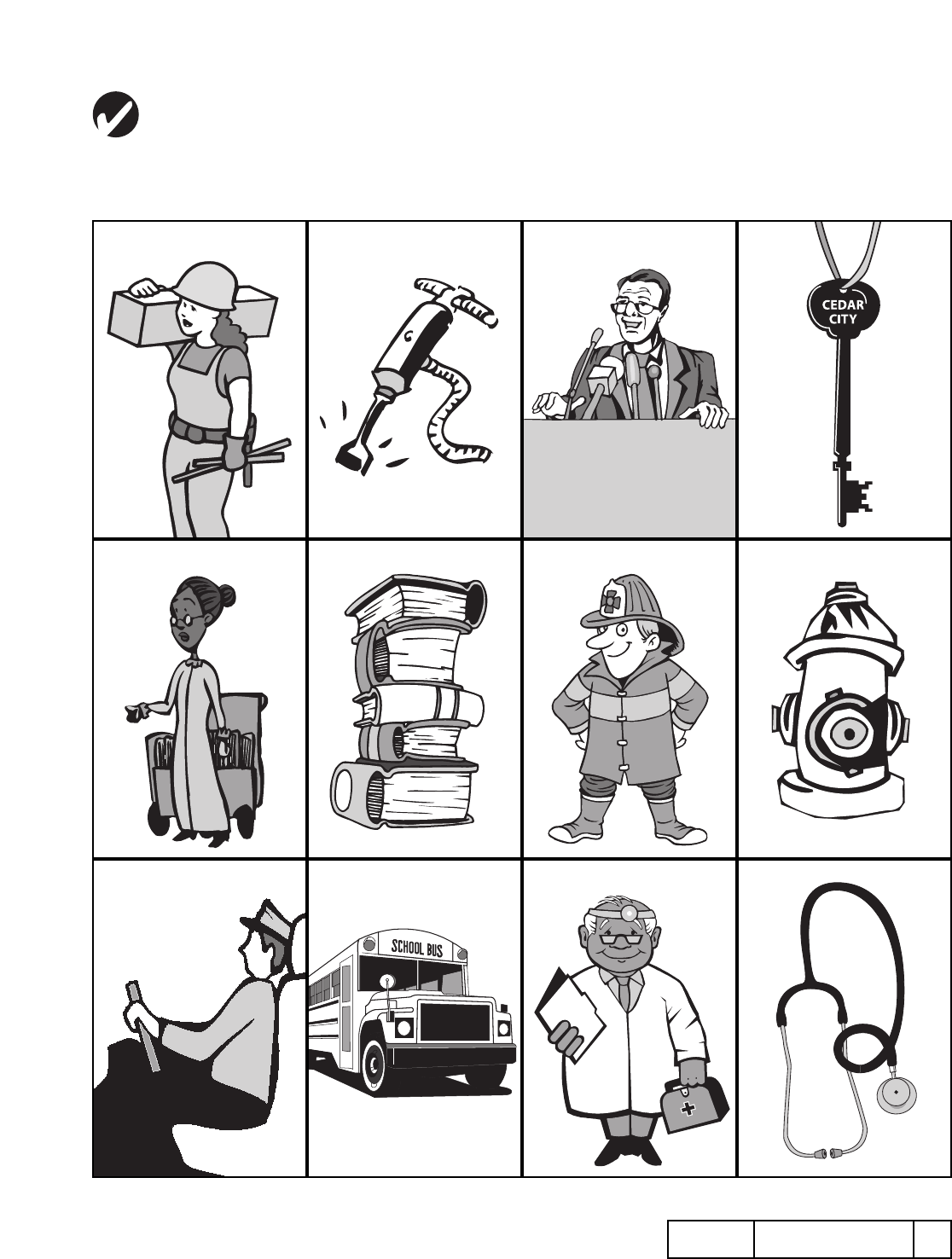
10ACTIVE CITIZENSHIPGrades K-2
©2005 Kids Voting USA, Inc. – All rights reserved.
MATCH COMMUNITY HELPERS
CONSTRUCTION WORKER MAYOR
LIBRARIAN FIREMAN
MATCH COMMUNITY HELPERS
BUS DRIVER DOCTOR
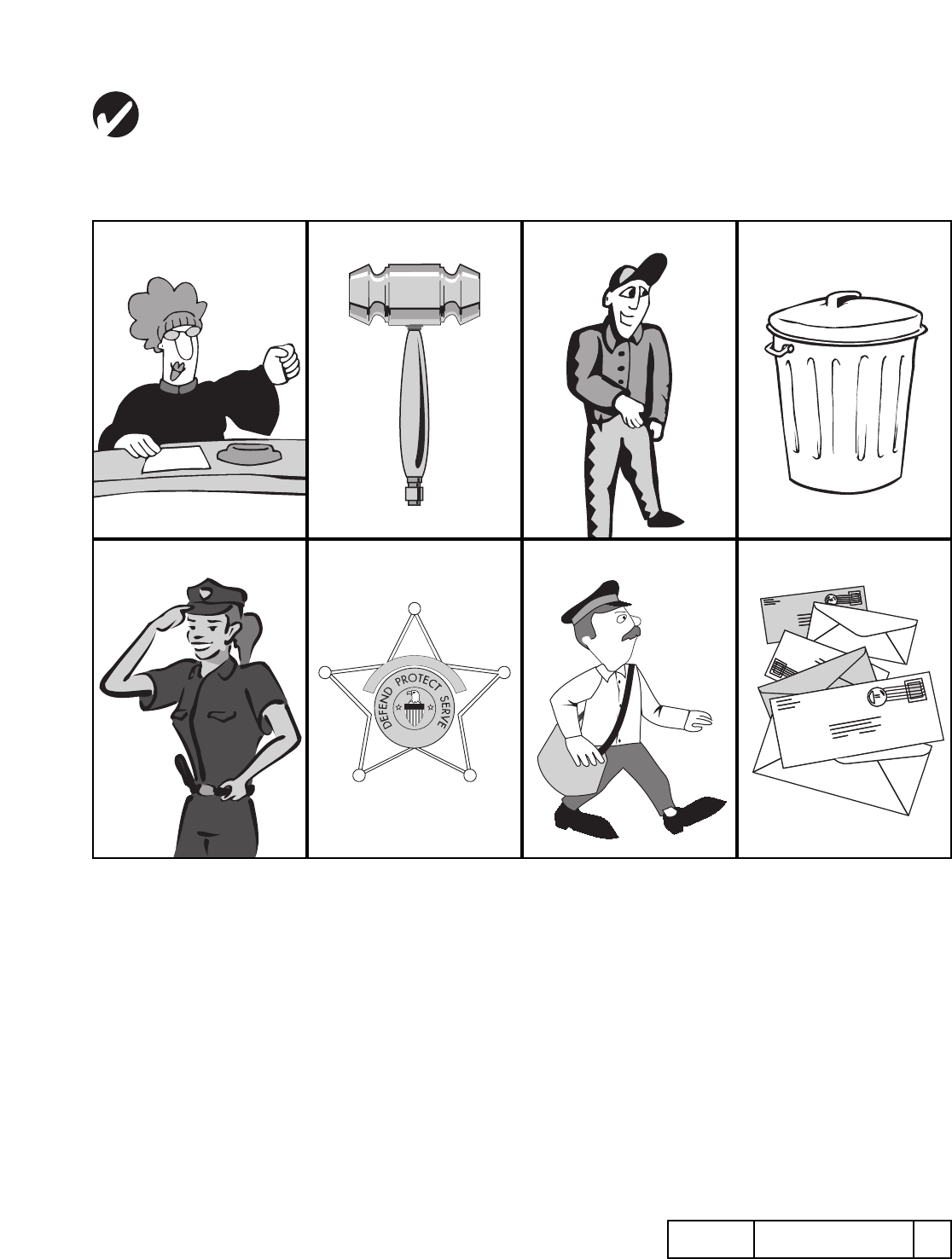
11ACTIVE CITIZENSHIPGrades K-2
©2005 Kids Voting USA, Inc. – All rights reserved.
MATCH COMMUNITY HELPERS
MATCH COMMUNITY HELPERS
JUDGE SANITATION WORKER
POLICE OFFICER MAIL CARRIER

12ACTIVE CITIZENSHIPGrades K-2
©2005 Kids Voting USA, Inc. – All rights reserved.
K–2
ACTIVE CITIZENSHIP
Having an Impact
OBJECTIVE
Students write a suggestion for their community
o
n a “campaign button” which also acts as a
reminder for parents and guardians to vote.
MATERIALS
If Elected… handout; tape; markers, colored
pencils, crayons, etc.
GET READY
Duplicate If Elected… Buttons.
Gather colored pencils, marking pens, etc. for
decorating the buttons.
This activity works best close to an election,
preferably a mayoral election, but it is not
essential.
INSTRUCTIONS
Say, Let’s pretend that each one of you is a
candidate for mayor, and you need to do one
important thing for our community. What
would that be? (Possible student responses:
make the community cleaner, create more
parks, support the police, and so on.)
Tell students to write or draw their idea on the
button handout. Remind your students to think
of an improvement that would benefit the entire
community. (Students can draw a picture of
what they would do if they do not have a strong
ability to write.)
Give students time to color and cut out the
buttons as well as to write their ideas. Make
adhesive tape “hinges” to attach the buttons to
their shirts.
Have students share their suggestions with the
class by forming an “Inside Outside Circle” to
read each other’s ideas. (It also makes good
reading practice.) Children form two
concentric circles and turn to face each other.
After reading the partners’ buttons, one circle
moves clockwise to the next person and the
new pairs read each others’ buttons. Proceed
until perhaps five pairs have shared.
DISCUSSION QUESTIONS
# What were some of your suggestions?
Who would benefit from these improvements?
# Is there a way that you can help your
suggestion come true? What can you do?
# How might voting make your suggestions for
our town a reality?
IF ELECTED…
(20-30 minutes)
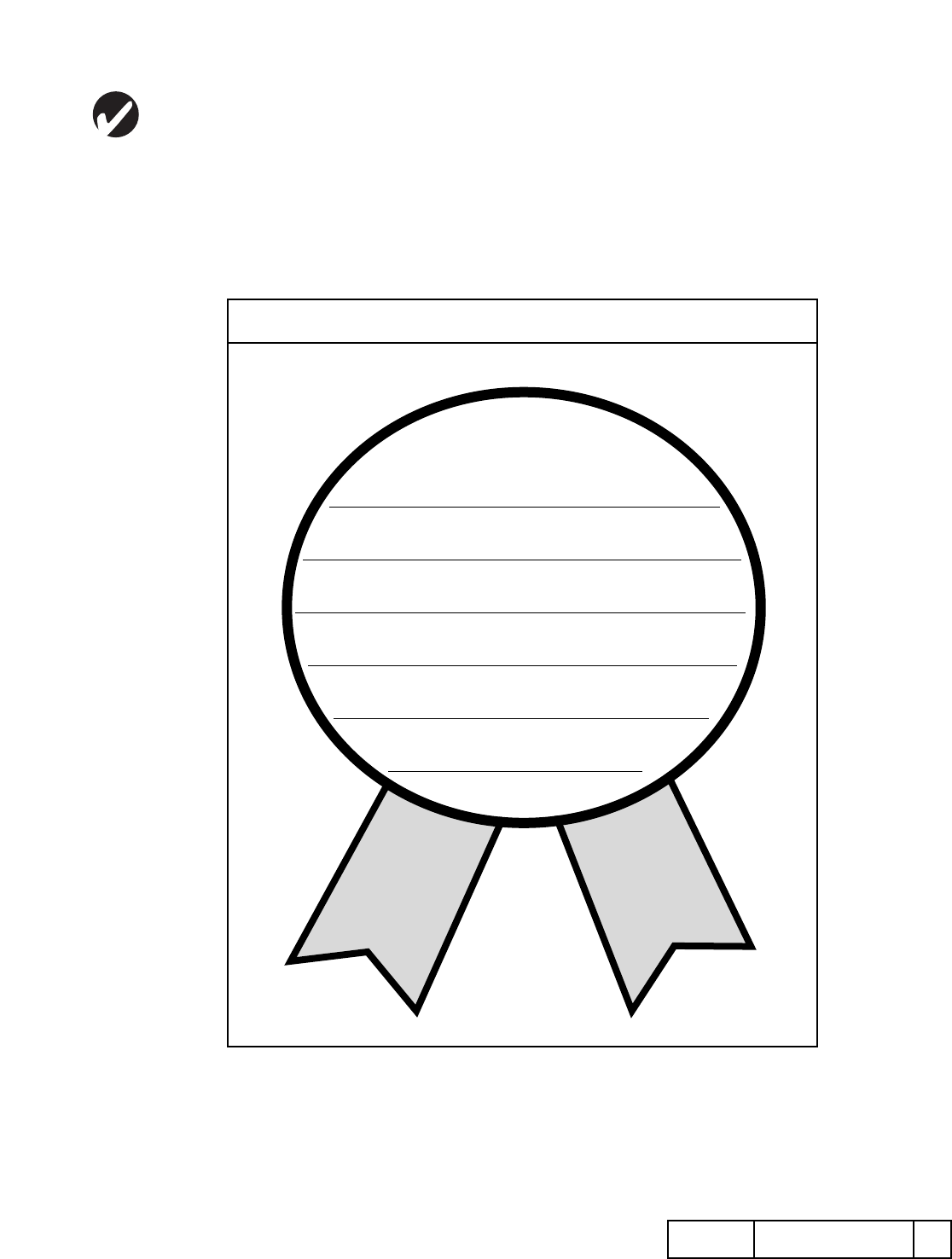
CAMPAIGN BUTTON
13ACTIVE CITIZENSHIPGrades K-2
©2005 Kids Voting USA, Inc. – All rights reserved.
IF ELECTED…
IF ELECTED…
IF ELECTED…

14ACTIVE CITIZENSHIPGrades K-2
©2005 Kids Voting USA, Inc. – All rights reserved.
K–2
ACTIVE CITIZENSHIP
Having an Impact
OBJECTIVE
Students prepare postcards to send to their
parents or guardians.
MATERIALS
Sheets of cardstock; crayons, markers, paper
cutter, scissors
GET READY
Prepare “postcards” by cutting sheets of card-
stock in half on the paper cutter or with scissors.
Gather crayons and markers.
Bring in some stamps to show students how
often political figures are used. (They may
choose to draw a president on their own
“stamps” too.)
INSTRUCTIONS
Say, We receive reminders in the mail to visit
the dentist or to meet at a restaurant for a
birthday treat. Today, you are going to create
a reminder about an upcoming election or an
issue important to your family.
Have your students draw a picture and write a
message about the election or issue on one
side of their “postcard.” The message can be as
simple as “Vote!” or “Recycle!” or they can write
a longer message. Tell them to draw a stamp
on the other side, to address it to the recipient
of the postcard: “Mom” “Dad” “Tom” etc., and
to sign or write their own name as well.
Remind students to deliver their postcard
when they get home.
DISCUSSION QUESTIONS
# What are other ways we can send reminders to
adults? (Letter, e-mails)
# How can we remind other students at our
school to vote, recycle, etc.?
# How are we helping our town if we deliver our
cards and messages?
POSTCARDS
(20 minutes)

15ACTIVE CITIZENSHIPGrades K-2
©2005 Kids Voting USA, Inc. – All rights reserved.
K–2
ACTIVE CITIZENSHIP
Having an Impact
OBJECTIVE
Students learn about different problems in the
local community, choose one, and brainstorm
ways they can make a difference.
MATERIALS
No materials are necessary for this activity.
GET READY
Arrange to have someone from the community
come to your class and speak about local
community needs and problems.
INSTRUCTIONS
For homework one night, ask students to talk
to their parents/guardians about what they
think are the most important community
needs and/or problems. Have students share
their findings with the class while you add
them to a list on the board. Then have your
students come up with any additional ideas to
add to the board.
The next day, have someone from the
community come to your class to speak about
local community needs and problems. This
could be a public official such as the mayor or
a city council member or someone who works
for an umbrella social service organization such
as United Way. Ask the speaker to talk with the
class about current community problems.
Encourage your students to ask questions so
they can learn how/why the problems
originated and what they can do to help.
Have each student select what they think is the
most important problem. Have them consider:
a) What issue interested me the most?,
b) What issue matters the most to me, my
neighborhood, and my community?
c) What could I do to help solve this problem?
Have your students share their problems and
solutions with the class. For example, if a
student selects too much trash in the community
as a problem, some solutions include recycling,
encouraging others to not litter, and throwing
away trash in parks and playgrounds.
DISCUSSION QUESTIONS
# What are some of our community’s needs
and problems?
# When have you noticed some of these
problems in our community?
# What are some solutions to these problems?
Why do you think these are good solutions?
# What are some of the sources of these
problems? How do you think they started?
# What can we do as individuals to help prevent
these problems?
# What can we do as a class to help prevent
these problems?
MORE!
Have your students share things they do to
address community problems. Encourage them
to make class announcements when they do
something to help the community.
TARGETING PROBLEMS IN MY COMMUNITY
(30-45 minutes)

16ACTIVE CITIZENSHIPGrades K-2
©2005 Kids Voting USA, Inc. – All rights reserved.
K–2
ACTIVE CITIZENSHIP
GATHERING AND WEIGHING INFORMATION
# Why is information important?
# What are sources of information?
# Is everything you hear true?
# How do you decide if something is true?
# What is a decision?
# How do you make decisions?
# What makes some decisions good and other ones bad?
# Tell me about a decision you have made? Do you think it was a good decision, why or why not?
COMMUNICATING YOUR POSITION
# Have you ever told anyone how you felt about something that was important to you?
# Is it always easy to say how you feel?
# What do you think is a good way to share an opinion with someone else?
# Do people always agree with you?
# What do you do when someone disagrees with you?
# Do you know what it means to communicate?
# What makes a good communicator?
WORKING TOGETHER
# What does it mean to work well with others?
# Is it always easy to work with others?
# What can be difficult about working with others?
# What does it mean to be a good listener?
# Can it be fun to work with other people? How?
# Is there a time when you had to work with other people? How did it go?
# What advice would you give someone who needs to work with other people?
HAVING AN IMPACT
# What is a community?
# Are there any problems in your community?
# Do you think adults are the only people that make a difference in your community? Why or why not?
# Are there things that you can do to help your community? What are some ideas?
# Do you think it would be hard to create change in your community? If so, what do you think
would be hard about it?
# Was there a time you did something good for your community? Please tell me about it.
OVERARCHING QUESTIONS

17ACTIVE CITIZENSHIPGrades K-2
©2005 Kids Voting USA, Inc. – All rights reserved.
K–2
ACTIVE CITIZENSHIP
OBJECTIVE
Students learn what it means to create positive
change in their community.
MATERIALS
Miss Rumphius - Barbara Cooney
PRE-READING ACTIVITY
Take your students on a “picture walk.”
Turn from page to page through the book,
asking your students what they see and what
they think is happening in the story.
After going through the book, have your
students make predictions about the story’s
plot. Ask, What do you think this book is about?
Who do you think the main character in the book
is? Did you see anything that looked familiar?
Did you see anything that looked confusing?
Read Miss Rumphius and make sure to
reference the students’ predictions during and
after reading it.
DISCUSSION QUESTIONS
# Why do you think Alice’s grandfather told her
that she needed to do something to make the
world more beautiful?
# Where did Miss Rumphius get the idea to
spread flower seeds everywhere?
#
What difference did it make that Miss Rumphius
had spread the seeds?
# People called her crazy for spreading the seeds
around town. How does that make you feel? Why?
# Is it always easy to do good things? What can
make it difficult?
# Do you think the flowers will go away if Miss
Rumphius does not continue to plant them?
Who else could spread the seeds?
# Think about Miss Rumphius. Can one person’s
good intentions and actions make a difference?
# What can you do to make your community a
better place to live?
ACTIVITY
Have your students think of ways they could
make their community a better place to live.
Keep track of these ideas by writing them on
the board.
Tell your students to draw a picture that
represents what they can do to improve their
community. Remind them of how Miss
Rumphius made her town more beautiful.
Have students share their pictures with the
class and explain the change they would bring
to the community.
As a class, decide on one thing you can do to
improve your town, school, or even your
classroom community.
Carry out this project and invite parents and
community members to come and celebrate it.
LITERATURE CONNECTION ACTIVITY
Miss Rumphius
by Barbara Cooney

18ACTIVE CITIZENSHIPGrades K-2
©2005 Kids Voting USA, Inc. – All rights reserved.
K–2
ACTIVE CITIZENSHIP
OBJECTIVE
Students choose and complete a service activity
designed to address a local community problem.
MATERIALS
Depends on the service project selected
GET READY
Prepare newspaper articles that discuss
community problems: trash, hunger, etc.
Consider things that will determine the nature
of the service-learning project: money,
transportation, supervision, etc.
INSTRUCTIONS
Have your class brainstorm problems in the
community. You may want to bring in a local
newspaper, or newspaper articles, and read
sections of it to your class.
Keep track of the problems mentioned by your
class by writing them on the board.
Tell your class that they are going to address
one of the problems, but they first need to
choose a problem. Have them select the
problem by a show of hands or a similar
democratic process.
Now that you have a problem for your class to
address, ask your students to come up with
possible solutions to the problem. (These ideas
represent possible service projects.) List these
ideas on the board.
In order to identify the correct project for your
class, encourage your students to consider the
following questions:
How much time do we have for the
service activity?
What kinds of support do we need
(money, transportation, adult
supervision) and where can we find
this support?
Which ideas are likely to have the
greatest impact on the problem?
Which ideas do we most want to do?
Note: It is important as the teacher that you
“veto” any ideas that the students are
advocating but that you find unacceptable or
unreasonable. Be sure to explain to the
students why that idea will not be included in
the final list.
Vote on a service project idea for the class to
complete. (If you and your students are
ambitious and have the time, you could choose
more than one.)
Make arrangements to carry out the project,
including contacting the people and/or organi-
zations needed for its success. Allow enough
time for your class to complete the project.
After completing the service project, have
students reflect on their experience in writing
or discussion.
To conclude the experience, celebrate students’
efforts to make a difference. This could be as
simple as a popcorn party, extra recess, or a
pizza picnic to as involved as a public event in
the community with guest speakers and
student awards.
CULMINATING ACTIVITY: WHAT’S THE PROBLEM?
(45-60 minutes in class; time varies out of class)

19ACTIVE CITIZENSHIPGrades K-2
©2005 Kids Voting USA, Inc. – All rights reserved.
K–2
ACTIVE CITIZENSHIP
DISCUSSION QUESTIONS
# Was it hard to come up with a service project
for the class? Why or why not?
# What was hard, easy, fun or difficult about the
service experience?
# Did the class make a difference?
# Were we able to influence public opinion
regarding the problem?
# What did we learn from this experience and
how could we apply that learning to future
efforts to improve our community?
MORE!
If the service idea chosen didn’t involve
influencing public opinion about the issue, you
might also want to include one of the
following activities:
Writing a letter to the editor or a public
official in the community about the
problem
Organizing a public display with facts,
artwork, and any other information
you can think of
CULMINATING ACTIVITY: WHAT’S THE PROBLEM? (continued)
